ICCM National Office
City of London Cemetery, Aldersbrook Road, Manor Park, London E12 5DQ
Tel: 020 8989 4661
enquiries@iccm-uk.com www.iccm-uk.com
2023
Autumn
Dead good words
Lets take about death
What ever happened to manners
Running for Bliss
Ashes to blooms
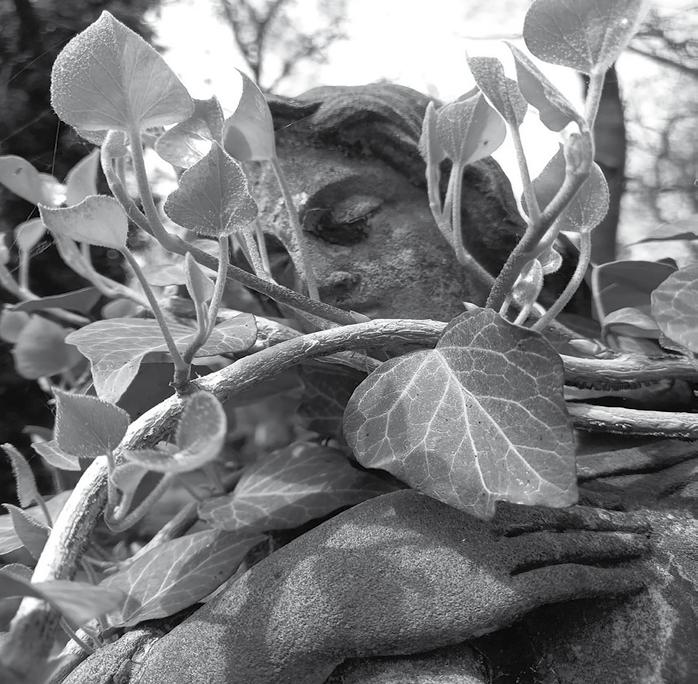
Soil management and drainage in cemeteries
The RHS Chelsea flower show at Hurlet A look at London’s Victorian cemeteries Pt. 4
Promoting and Developing Best Practice in Cemeteries & Crematoria
The Journal Autumn 2023
the journal
Why use Burial Vaults?

The Atlas II vault is exceptionally strong and protective in its construction.
Coming complete with its own hermetic seal, the twopart chamber is extremely useful and very quick and easy to install.
There is no need to extend any dig sizes to accommodate brick or block constructed chambers, no purchase of cement, mixing or brick laying. These chambers are easily installed by two persons.
The chambers are completely air and gas tight as well as watertight, meaning everything is sealed to the maximum, making them ideal for shallow depth burial as well as peace of mind for bereaved families.

Available now - contact us today to find out more or place an order.
ATLAS II Features
• Hermetically sealed for total integrity
• Incorporates three picture frames on the top panel for personalisation - loved ones can attach photographs, letters and notes as memorials
• Engineered with 32 cross ribs and 12 counter ribbing supports
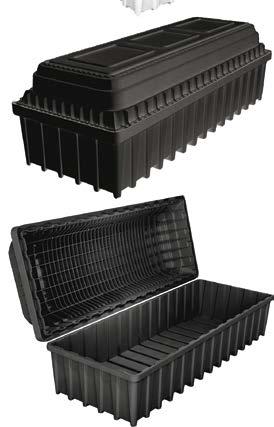

• Engineered with a 180o reinforced channeled edge for additional strength
• Engineered using high-density, water-resistant, non-porous and non-biodegradable polypropylene
• Nestable for easy storage

• Lightweight construction for safe and easy handling
• Certified load-bearing capacity
• Compression strength tested to 12,100lbs
• Consistent .250 wall thickness and numerous 90o corners for structural strength
• Mastic sealant included for a permanent seal
Clear Skies Software Limited, 3 Herald House, 4/6 High Street, Westerham, Kent TN16 1RF Tel: 0870 240 2217 • Email: info@cssmail.biz • www.clearskiessoftware.com Some things just make sense. Clearly. We’ve worked hard on our software so you don’t have to. BACAS is simple to use and can be tailored to your specific requirements. Call ClearSkies Software on 0870 240 2217 for further information or to arrange a demonstration of the BACAS system Some of the many BACAS features are: n Burial and Cremation administration n Register Searches n Memorial administration and Risk Assessment n Finance n Mapping n Telephone Booking n Custom Documents and Statistics n Internet systems including Diary, Genealogy, Bookings and Memorials n Hosting n Coffin lowering device n Register scanning and indexing Bu RIA l AND C R e MATI o N A DMINISTRATI o N Sy ST e M BACAS from t: 01495 212 232 e: info@teleshore.com www.teleshoregroup.com New RANGE OF BURIAL VAULTS - AVAILABLE NOW
The ICCM Journal | Autumn | V91 No. 3 1 Publication & Advertising T: 020 8989 4661 Email: enquiries@iccm-uk.com Subscription Rates £50 per annum (4 issues) Payment to ‘ICCM’, or an official order sent to; Trevor Robson ICCM Finance & IT Manager 1 Colbeck Avenue Swalwell Newcastle upon Tyne NE16 3EB regulars features DNA memorial 10 Dr. Ryan Lehto Barnsley Council pet crematorium 12 Anthony Devonport Unsung heroes King’s coronation celebration 16 Linds Francis Rushcliffe Oaks crematorium 19 Ronda Churchill Whatever happened to manners 21 David Jennings ICCM recycling of metals scheme 23 Bariatric funerals 29 Richard Smith Dead good words 30 Poppy Mardell Soil management and drainage in cemeteries 31 Sofia Allana Lets talk about death 38 Dr Lesel Dawson, Rachel Hare, Dr Lucy E. Selman, Tracey Boseley, Alison Penny MBE, John Adams Lea Fields crematorium 41 Katie Smith The cemeteries and crematoria group meeting 43 Alan José Want to maximize your online presence for free? 47 Eimer Duffy Tales of a cemetery registrar 48 Anita Fish The RHS Chelsea flower show to the Hurlet 52 David McNaughton Communication is key 53 Lisa Fiddimore Poole crematorium refurbishment 54 Liz Hall A look at London's Victorian cemeteries: Part 4 59 Brian Parsons Ashes to blooms 64 David Holmes Improving service reputation by helping the bereaved deal with the burden 59 of admin following a death Dan Blackett Running for Bliss 67 Peter Haley Cancer research charity hike 69 Liz Buckley 51 mile charity walk - team fundraising for multiple charities 69 2023 Published by The Institute of Cemetery & Crematorium Management (Inc) City of London Cemetery Aldersbrook Road London E12 5DQ Printed and distributed by Sudbury Print Group Ballingdon Hill Industrial Estate Sudbury, Suffolk CO10 2DX T: 01787 373421 © Institute of Cemetery & Crematorium Management (Inc.) The Journal is published quarterly in March, June, September and December. Copy dates: 15 Jan, 15 Apr, 15 July, 15 Oct. ISSN 1747-129X Cover image supplied by Sofia Allana Editorial 2 President's Page 4 ICCM In Touch 9 Company News 44 In Touch Up North 51 ICCM Directors and Officers 71 Advertiser Index 72
The Power of Words
“Sticks and stones may break my bones, but words can never hurt me”. Remember that phrase? The implication being that physical injury is more painful than psychological or emotional injury – but this is not necessarily true. Scientific studies actually show that positive and negative words not only affect us on a deep psychological level, but they have a significant impact on the outcome of our lives.
Just as negative words can release anxiety and stress hormones, positive language can have the opposite effect. Thinking about what we say, how we say it and the words we use can have a huge impact on those bereaved families in our care. We know that relationships lie at the core of our role, and that language shapes our human interactions. So, how can we make a shift in the language we use in our daily work lives to reduce the negative and often painful associations with grief.
In my early working career, I worked in the electrical and lighting industry. It was very male dominated, where the customer base was mainly tradesman – banter was the everyday language with very little need to be mindful or sensitive about the words chosen (probably not allowed today but 25 years ago we had no HR!) I went from that to bereavement care. I learnt very early on those everyday common phrases, which I had not given any previous thought to, had a huge impact in my new working environment. Common courtesies such as “How are you?” and “Happy Christmas” held a deeper meaning for those families I dealt with, and I learnt, the hard way, that I had to choose my words carefully.
Various grief training and personal experience has made me much more aware of my language and the phrases used when speaking with a bereaved person. Common platitudes include, “I know how you feel”, “they’re in a better place now” and “at least he’s not suffering anymore” or “you’ll get over it”. These are things not to say but are frequently used. Often people simply don’t know what to say but saying nothing at all can be just as impactful as someone saying the wrong thing (even with good intention!).
Unfortunately, in the last 6 months I have attended two funerals, both died suddenly, both in their 30’s and both related to each other. Apart from the obvious shock and sadness, what really touched me was the eulogies presented at both funerals, from close family members, where grief is still so raw. Despite this, through the power of words, they were able to give us a window into the world of their lives, delivered with humour. They recounted personal stories that reflected their personalities and made us remember that we all have an impact on those around us in some way or another.
Poppy’s Funeral Directors has a manifesto for change in language we use in death called #Deadgoodwords. There is an article in the Journal giving the details so please take a moment to read it and contribute your thoughts.
Grief has its own language and words matter. What we say, how we say it, and who we say it to matters, because those around us can be greatly impacted by the language we use and the words we choose to communicate with.
Sofia Allana Editor
editorial
The ICCM Journal | Autumn 2023 | V91 No. 3 2




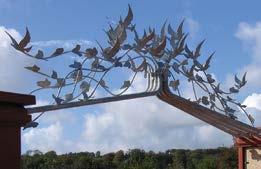

Visit us at www.welters-worldwide.com Or contact us via email: admin@welters-worldwide.com welters ® ORGANISATION WORLDWIDE Concept Originators Above and below ground full body interment options
Cremated remains interment features Memorialised decorative sculptures
An example of Bronze Memorial Art - fabricated in Britain by welters®
president's page



Hello and now for the final time as President I am writing my last page. I hope you are all well and that you have enjoyed the summer.
I celebrated my 60th birthday in May and had a lovely trip to Venice, but unfortunately, I returned with a nasty cold and missed the National Association of Funeral Directors’ President’s Banquet held at the Crowne Plaza Hotel in Straford-upon-Avon which was a shame, so sorry no pudding photos from that, however a little something from Venice for you instead ��
On Wednesday 7th June, my colleague Claire Hodges and I were honoured to attend the service of dedication at Westerleigh’s Waseley Hills Crematorium and Memorial Garden in Rubery, Birmingham. We were welcomed by Joy Edington, crematorium manager and listened to prayers by Rev Phelim O’Hare and Kevin Ward accompanied by Steve Cowperthawaite who performed two wonderful pieces, Ave Verum Corpus and Bridge Over Troubled Water, which he slightly changed the lyrics to make it more fitting to the funeral industry which was very emotional. Alan José, Westerleigh Group Ambassador, gave an address during the service and afterwards we all retired to a marquee set up in the beautiful grounds, and I am sure you know where this is going ……… the lunch was delicious especially for me, the pudding �� obviously I took a photo, it would have been so disappointing for you all if I hadn’t!
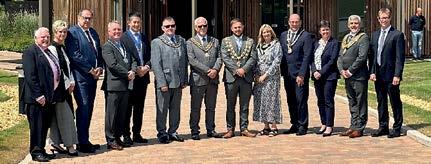


On Tuesday 27th June I attended the CBCE Banquet with my work colleague Gill Douglas, on our own stomping ground at the lovely Hilton at the Ageas Bowl in Southampton, just a stone’s throw from my home. The evening was wonderful with delicious food and great company, meeting up with old and new work colleagues. Don’t worry there is a pudding photo for you to savour. We enjoyed great company around our table and a dance to the music played by the DJ. The raffle raised a considerable sum for Cruse, with some lovely prizes including lots of bottles of champagne “donated by the Westerleigh Group” which become almost like a catch phrase as the evening progressed.
On Wednesday 12th July I attended another Westerleigh dedication service with my work colleague Claire, this time at the beautiful New Forest crematorium. We arrived a little early and were given a tour around some of the grounds in style with a horse and carriage ride.


4 The ICCM Journal | Autumn 2023 | V91 No. 3
Inside the Chapel we were welcomed by Graeme Horobin, crematorium manager and listened to prayers and readings by Bishop Debbie Sellin, Minister Martyn Douglas and Humanist Celebrant David Hewitt. A wonderful choir sang two lovely pieces, You Are The New Day and Sing Gently and also accompanied the hymns we sang. Ed Lane Operations Director gave the closing address.
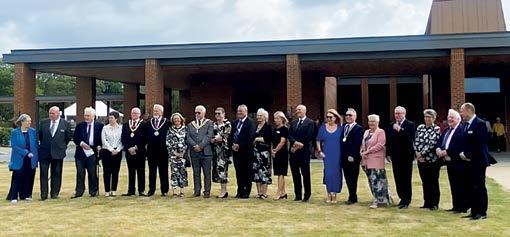






The ICCM Journal | Autumn 2023 | V91 No. 3 5
Outside we lined up for the obligatory “chain gang” photo.
Manage mason requests online.






Introducing the PlotBox Memorial Mason Portal.



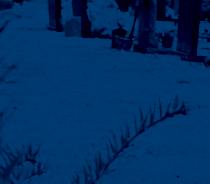




Our latest innovation allows you to manage stonemason requests for work permits online. No more back and forth via phone, fax or post, with all of your communications now in one place. View, approve, track and sign off in a single, streamlined process that puts you firmly in control – improving communication, saving time and ensuring compliance.

Belfast Boston Sydney 028 2582 1005 www.plotbox.io info@plotbox.io SCAN TO LEARN MORE
Custom canopies, walkways, floral tributes, and porte cochères to enhance your facility




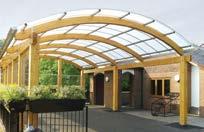

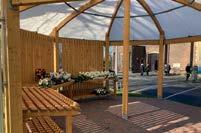

With over 55 years experience and industry leading guarantees on all our projects, we can assist at pre-planning stages to minimise lifecycle costs of your refurbishment or new-build structure.
With our experts to hand at all stages, you can trust us to complete the works on your establishment to time and to budget. Offering nationwide installation and bespoke service, Fordingbridge have just the solution to your outdoor spaces.
• Canopies
• Walkways
• Porte cocheres
• Floral tribute display spaces
• Sustainable buildings
• Tensile fabric structures

7
We then went through the grounds to a marquee to be greeted with welcome drinks and delicious “grazing” boxes. Oh, look not an actual pudding photo, but very delicious ��

So those were the final visits I have made, I hope you have enjoyed reading about them as much as I have enjoyed being there.
July saw the national medical examiners update being produced following their conference in May, I really thought that in my 3 or more years as President I might have seen its full introduction, but that was not to be unfortunately. The update focused on several different issues such as GP study days, podcasts, the implementation in Wales, digitised Medical Certificate of Cause of Death and good practices around dementia. It made a very interesting read, but it will remain to be seen as to whether it will all come together next year as planned.
As you read this you will already have voted in your next Deputy President, and I will be handing over my chain to Marian Millington who will finally get to take on her role as President. It seems so long since I stood at the 2019 AGM and took over the role, so many things have happened in that time and I have appreciated all the love and support that I have received from all my family, friends, work colleagues and fellow ICCM members. Some of my time as President has been sad with the dreaded Covid and the most difficult time of my life following the loss of our beautiful grandson Harlee.
But other times have been happy and uplifting, and I have thoroughly enjoyed meeting new people, making new friends and spending time with old acquaintances (and I don’t mean just in age!!).
I hope you can make it to this year’s Learning Convention and Exhibition at the Chesford Grange on the 18th to 20th September, where the emphasis will be on Learning, and I look forward to seeing you all there when I give my final address, or if you read this after the event it was lovely to see you, if you made it ��
And now “The Final Empty Plate” and the end of an era for me……
As always, I send you all my love and thank you for your valued support and friendship.

8 The ICCM Journal | Autumn 2023 | V91 No. 3
Heather White
To find out how to advertise in the Journal, please visit the ICCM website at www.iccm-uk.com, or email sofia.allana@iccm-uk.com
in touch
Autumn 2023
It hardly seems possible that the longest day has been and gone and we have had the best of the summer and are heading into Autumn at a vast rate of knots. It doesn’t seem two minutes since I was writing the first In Touch of 2023 for the Spring Journal, but soon I will be contemplating the Winter one. If time goes faster the older you get, I reckon I must be about 500 at the moment!
I think time must be flashing past because I’m incredibly lucky to love my job. No two working days are ever the same, but they all feature providing support to you, our members, so that you can do your job. I hope you love your job as much as I love mine. Helping bereaved people through difficult times is not for everyone, but if you’re reading this, it probably is for you. We aim to give you the tools to do it well, though our events, education and training programmes, our best practice guidance and our email and telephone support.
We are a unique organisation in the bereavement sector; our team of full-time officers have ‘been there and done that’, ie we have been in your shoes and have faced many of the problems and issues that you have or will face in your daily work. Between myself and the Technical Officers, we have 75 years of experience working in cemeteries and crematoria. That’s a lot of knowledge and skills that we are keen to share with you. Many of our phone calls start with ‘I know this is a silly question’. Please be assured that we would never think that; we are firm believers that there is no such thing as a silly question. If in doubt, phone us, or email us (contact details are at the back of this Journal and on our website). We’d rather you asked than took a risk. We will never judge you for not knowing something or wanting to check it with us.
I had a lovely comment from a member recently when I confirmed a way forward on a particular issue that was simpler than they had feared. When I explained what they needed to do, they thanked me and said they could hug me, then queried if that was appropriate. Absolutely it was appropriate! We are very much in favour of hugs at the ICCM, physical, virtual and metaphorical*. The two years of the pandemic limited our exposure to physical hugs, but it was great to receive some virtual ones through our online training courses and regular webinars. We don’t do our jobs just to receive hugs, but it’s nice when it happens.
Being ‘back in the room’ at last year’s Learning Convention and Exhibition was great after a two year hiatus due to the Covid-19 pandemic. There were hugs aplenty, but more importantly members were able to able to learn in a conducive environment. That is what the event is all about – LEARNING. Learning is a continuous process, and nobody can ever know everything they need to. Things are changing and evolving all the time, and we need to change and evolve with them to make sure we continue to provide the best service possible to bereaved people. The Learning Convention provides an excellent opportunity to stay up to date with what is happening in the sector. The talks and workshops provide not only information, but also inspiration and food for thought. The exhibition stands are a wealth of good ideas and each supplier is more than happy to talk to you and discuss ways for taking your service forward. The event is also a great place to meet colleagues from around the UK and to learn from each other. It is a really friendly event, and whether you’ve been before or it’s you first time, you will receive a warm welcome and soon be amongst friends.
We are aware that funding for attending events is limited, but the value in terms of learning and development goes way beyond the low attendance price. We have done all we can to keep the price low to encourage as many members as possible to attend. We’ve even made it free to attend the exhibition if funding isn’t available to attend the whole event. So, whether you come for a half day, a whole day, to visit the exhibition or to attend the whole event, you will leave feeling refreshed, inspired, supported and with a new found love for your job. That has to be valuable to your employers, surely?
To book your place at the Learning Convention and Exhibition 2023, visit the ICCM website at www.iccm-uk.com.

I look forward to seeing you there.
*Of course the giving and receiving of hugs must be consensual on the part of the giver and the receiver.
Julie Dunk ICCM Chief Executive
The ICCM Journal | Autumn 2023 | V91 No. 3 9
dna memorial
DNA Memorial is now the final place where families can collect their loved one's DNA before it is lost forever. This DNA can preserve the entire family's medical history, predict diseases, and even lead to future cures. For instance, a woman named Sarah in Toronto, Canada, survived breast cancer at 37 but had her mother's and grandmother's DNA already preserved, which allowed doctors to predict that her teenage daughter would develop breast cancer at an early age. The daughter began yearly screening, and when she developed breast cancer, she was treated immediately, avoiding the ordeal her mother endured. Family history and legacy is also very important to families and by saving the DNA you can make connections to your ancestors. Your genetic history is embedded in your DNA and as more and more markets are discovered we can trace not only to areas and ethnic groups but to actual individuals that lived thousands of years ago. By saving your DNA you also solidify your place on the new family tree.
We only know about 5% of what DNA does and that in itself is very powerful; but there is also new research indicating the possibility of some sort of memory passed between generations genetically. This would explain instinctive behaviours in animals for instance. There are legal matters where having DNA can assist, for example legal claims and where paternity etc is in question. The process for collection is simple these days and needs only simple mouth swabs taken before or after embalming.
Normally, extracted DNA must be stored at extremely low temperatures (-85c). The DNA Memorial service was set up by a group of Canadian scientists who have discovered a way of preserving DNA in people's homes without the need for refrigeration - meaning the sample can be kept until it is needed. The manufacturer says it could remain intact for 500 years or more.
The DNA Memorial service is already available in Canada and the US. After the sample is taken by the funeral home (the swab is taken from the inside of the cheek), it is sent to a specialist laboratory where the DNA is extracted from the cells in the swab sample, purified, treated so that it is stable and then sealed in a sterile vial filled with an inert gas to protect it from oxygen.
It will be returned to the family for safekeeping until needed.
The service doesn't offer analysis of the DNA sample - the idea is this will be done by doctors, if it's deemed necessary, at a later stage.
The problem for the UK (or more specifically, England, Wales and Northern Ireland) is the Human Tissue Act 2004. Unintended consequences of the legislation mean that a funeral home or hospice would require an HTA license for the premises for the collection of even a simple mouth swab. Simon Rothwell and Lesley Nott (Specialist DNA Forensic Client Case Manager, King’s College London), have been engaging with the HTA and stakeholders (including the NAFD) in an effort to make this process simpler for the bereaved. Currently, a deceased person needs to be moved to an HTA licensed premises (usually a hospital) for a 30 second cheek swab. Simon comments, “The UK is quite simply behind in terms of DNA collection and both Lesley and I have spoken to bereaved families who are clearly upset by this ridiculous process.” Simon and Lesley are continuing to try and implement change for the benefit of the bereaved going forward.
The DNA can also be made into keepsakes, such as pendants for example, similar to turning ashes into cremation jewellery.

The DNA substrate is encased within the pendant and sealed.

Advancements in science and technology will allow us to preserve some of the past for the future.
For more information, please visit the website https://dnamemorial.com/
Dr. Ryan Lehto CEO Genetic Health
10 The ICCM Journal | Autumn 2023 | V91 No. 3
One of the latest developments in funeral home evolution around the world is the collection of DNA but the UK is currently being left behind.


Showcase your cemetery to better serve your community Request a demonstration today Part of byondcloud, recordkeepr is a mapping and records management solution for cemetries of any size. Simple to use features deliver a wealth of capabilities for less than you imagine. Find the right information as and when it is needed Export reports that help identify cemetery capacity and inform future cemetery planning Easy navigation to burial and memorial locations opusxenta.com 0333 772 1682 Generate customised quotes and invoices Share the history of your cemetery with your community
barnsley council pet crematorium

Who thought we could do it!
Those of you who know me will know that I’m not shy when it comes to shouting about how much I enjoy working for Barnsley council and that Barnsley ought to be the capital of England, after all Yorkshire is God's own country!
Back in 2016 before COVID came along and our whole world went crazy, Barnsley council was stuck in another round of trying to balance the budget. I am sure you are all thoroughly fed up with this constant cycle of budget pressures and the squeeze on our dwindling budgets. The council decided that as well as the usual cuts there would be some monies available for innovative projects that would generate income. This took us all by surprise and was a welcome change to the usual head scratching trying to find budgets that could be cut without too much impact on the bereaved.
I can’t quite remember now, the COVID years blew my mind, but I attended the ICCM seminar either the year before or during 2016 and listened to a paper by Kevin Spurgeon from Dignity Pet Crematorium in Hampshire. This proved very interesting, and an embryo of an idea had started to grow, could we do something similar in Barnsley? To our knowledge no other local authority had done this before as we are used to delivering services not running commercial businesses.
A few internal discussions started within the team and the then crematorium supervisor Paul Beardsley, now retired, was really keen to get this up and running. Our finance team were just starting to think about how we process applications for the “commercial fund” and we were nipping at their heels to come forward with a business case. Finance quickly came up with a process and we successfully bid for a sum of money to undertake a feasibility study.
I quickly contacted Kevin at Dignity Pet crematorium to arrange a visit and a few months later we were on our way by train down to Hampshire. Kevin was very welcoming and showed us around his excellent facility. We visited a local vet on a collection and whilst we were driving around, we discussed the legal consents and aspects of the operation. Kevin is obviously so passionate about what he does and that reflects in the standards he operates to and those of his friendly staff. We came back to Yorkshire armed with loads of information and ideas.
Our next task was to look at where to site the pet crematorium. Do we want somewhere out of the way or accessible to the public? Are we offering collection only or are owners to drop their beloved pets off?
Fortunately for us we were at the time part of the culture department and the council owns a very grand country house called Cannon Hall. The hall was bequeathed to the council in the 1950’s by the Spencer family. It is now a fantastic local museum and listed landscaped gardens. Part of the grounds is dedicated to a walled kitchen garden and ancillary buildings which at one time served as gardeners' work sheds. This was an ideal spot for our pet crematorium, the grounds in particular are well frequented by dog walkers and several dog breeder clubs have monthly meets in and around the area. We had discounted the crematorium grounds as we did not want to run into any conversations around what or who was being cremated in each separate cremator. Silly I know but you know how daft rumours start!
Given we work in local government and there is always a form to fill in or a report to write we began by pulling a project plan together. Having settled on the site at Cannon Hall and its pulling power in terms of branding we sketched out our initial requirements.
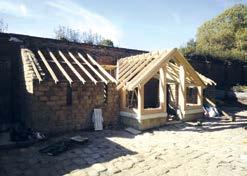
• Discreet location within the grounds
• Must be a standalone facility
• Sympathetic to Listed landscape and buildings
• Easily accessible
12 The ICCM Journal | Autumn 2023 | V91 No. 3
In addition, we had to have accurate costings and a reasonable timescale given the planning and legal consents we would have to obtain. The feasibility study was complete and showed just how many pets were within the locality and more importantly potential customers. Who knew that there were over 20 million companion animals in the UK?
In 2005, of the estimated 1.5 million pet dogs and cats that died each year in the UK, 300,000 were buried in the garden, 1,000 in pet cemeteries, 100,000 were individually cremated and of the rest (1.1 million approximately) 74% were disposed of as clinical waste, usually via mass incinerations and sometimes in landfill sites. Ten years on and the use of pet cremation has seen a significant increase. The reinforcement of the law in disposal of animal cadavers as clinical waste has produced a large uplift in the cremation of pet and other animal remains.
It is thought that at least half of animal owners hold funerals for their deceased pets. Perfect Choice (funeral plans), conducted a poll in the UK which set out to discover whether the UK truly is a nation of animal lovers. They surveyed 1,608 British adults over the age of 18 that had had a pet pass away within the last year to find out whether they had held a funeral for their pet and what they had spent on them.
They first asked the respondents whether they had held a funeral for their pet.
• 49% said no, with the majority of those giving the reason that they didn’t believe in commemorating the passing of an animal.
• 51% of respondents said yes, they had held some sort of funeral or memorial for their pet.
The pet most likely to have a funeral held for them were dogs; with cats second and third being rabbits. The research revealed that to many people the loss of a pet can be just as distressing as losing a family member and some were prepared to part with large sums of money in order to ensure that their pets were honoured in a dignified manner. As the pet funeral market grows this income stream is becoming more important and lucrative year on year.
Taking the pet ownership percentages from the 2014 Pet census then in the Barnsley District the pet population would probably be as follows:
• Dogs 34,650
• Cats 32,550
• Small Mammals 10,500
To calculate the annual total number of these animals reaching end of life by natural causes we have made the following assumptions:
• The average lifespan of a dog is probably 13 years
• The average lifespan of a cat is probably 15 years
• The average lifespan of a small animal is probably 6 years
These estimates do not take into consideration possible death by accident, sickness or premature euthanasia (strays, dangerous or injured animals).
Therefore the number of these pets reaching end of life by natural causes per annum would be approximately:
• Dogs 2665
• Cats 2170
• Small Mammals 1750
From these statistics we were confident that there was potential for the facility to become a success offering a much-needed service to the area but also an income stream to the council. My team were convinced but proving this to finance colleagues may be a challenge. This turned out not to be, finance was as keen as us to move forward with this project and following a briefing to senior politicians we were given the go ahead.
Tenders were issued and we were very fortunate that the successful bidder was a local firm called AD Copley. We have worked with this company on many projects both in the crematorium and in the cemeteries across the borough. Crucially they had a wealth of experience of working on listed buildings.
The work consisted of the provision of a standalone containerised pet cremator and a conversion of a gardener’s hut into an office and goodbye room for the bereaved. The goodbye room was the centrepiece with Norwegian spruce pillars and a stone roof.
Work commenced in early 2018 and quickly word got out what we were planning to build. We created a modest media campaign whilst we worked on the branding of the new pet crematorium. Work continued during the summer, and this didn’t go quite to plan. On clearing the ground we discovered a cobbled surface underneath the grass. Of course, this just had to be a listed structure! Our colleagues in the adjacent museum were overjoyed at the discovery, I’m not sure I was on this occasion. We had little choice but to incorporate this surface into the overall plan. On reflexion I am glad we did. It looks fantastic, particularly in the historic landscape. It is however terrible when it comes to pushing a bier/loader over it!
The ICCM Journal | Autumn 2023 | V91 No. 3 13
In tandem with the construction we have had to enter the world of the Rural Payments Agency and the Animal Plant Health Agency (APHA) to obtain a permit to operate. I thought local government was bureaucratic but this is a whole new level of pain! Thankfully the staff at the APHA are very friendly and they talked us through the process. We now have an operating permit and have annual inspections.
Our choice of cremator was limited in that it had to be stand alone. Fortunately we worked with Addfields from Birmingham who were absolutely fantastic, they knew what we wanted to fulfil our vision and were prepared to listen and work with us. We purchased their Pet 200 and it has been a great machine.
The work was finally completed in the autumn of 2018 and we scheduled a grand opening in November. The opening was conducted by our then cabinet member Cllr Roy Miller.

During 2018 the number of cremations were steady but low. The local vets generally are tied into contracts with big disposal firms so it was difficult to get into that market, we had to go for personal service and individual cremation.
Getting the word out has been the hardest part of the process. Adverts in local publications didn’t really hit the mark. Local radio however made a big difference. Our local radio station Dearne FM is part of the Bauer media group and therefore covers our neighbouring authorities as well as Barnsley. We decided to go for a short but snappy paid commercial. Wow what a difference that made, literally within a few months we could see the numbers beginning to rise. The word was out!
We are now conducting around 540 cremations a year bringing in a profit of around 30k per annum. Fuel prices have been a drag on profits this year with an additional 10k being spent on fuel due to the wholesale price of diesel being high. Hopefully this will fall back and increase our profits further.
Our current focus is now on how we cover weekends and into the early evening as this is an unmet demand. A further visit to the commercial board is also on the cards for a second cremator!
There has been some interest from other local authorities, and we have helped colleagues in Harrogate who have recently opened their own pet cremation service. Good luck to my friend Stephen Hemsworth and the team at Harrogate bereavement services. Others include Cardiff and Grimsby.
The one thing I have taken from this process is how hard it has been. Initially we thought build it and they will come, it didn’t turn out like that, it is really hard setting up a commercial business from scratch and getting people to come and use your services. That said the comments we receive from the families is heart-warming and it is a service that is welcomed and appreciated by the people of Barnsley and the surrounding areas. We also run a stone mason’s business but that’s another story………………….
14 The ICCM Journal | Autumn 2023 | V91 No. 3
Anthony Devonport (FICCM) Head of Service for Bereavement, Environment, Sport and Transport Services.
In the middle of arranging a Public Health Funeral?
We are Fraser and Fraser, a professional team of genealogists and international probate researchers, dedicated to tracing next-of-kin or relevant people generally.
Next-of-kin enquiries for Public Health Funeral Officers
If you are arranging a public funeral under s.46 Public Health Funeral Act, you can refer your case to us, and we can trace the family of the deceased, at no extra cost to the Local Authority.
Whether or not the family want to take on the funeral arrangements themselves, they’ll have the opportunity to attend and pay their respects.
We trace family members all over the UK and the rest of the world and have been working with the Public Sector for more than 50 years.
7832 1400
scan here to visit our website

To find out more,
nickbeetham@fraserandfraser.co.uk
contact us today
020
Or
unsung heroes king's coronation celebration
As we’re all aware those working within bereavement services do an amazing job of ensuring that cremations and burials go smoothly and to a high standard, working hard behind the scenes to resolve issues and accommodate requests, with very little recognition.
It was, therefore, a proud moment when members of the Buckinghamshire Crematoria & Cemeteries team were nominated as Community Unsung Heroes and were invited by the Lord Lieutenant Countess Howe to spend an afternoon in the picturesque gardens of Penn House in Amersham.

John Stevens, Stephanie Young, Clive Dickens and Jodie Warren were all thrilled to attend on behalf of the crematoria service and to represent the wider bereavement industry. It was a beautifully sunny day and the Amersham Band played to the guests throughout; Beatles, Bond and other well-known theme songs could be heard. A delightful selection of drinks and light tea food were also provided for guests.
The team enjoyed the opportunity to socialise outside of the normal working day and thought it was a great opportunity to get out of their ‘deathie uniforms’ and dress up! There was a huge turnout to the event, thankfully shaded by a large elegant marquee which had been provided by charity DrugFam and it was a privilege to be considered a part of a momentous occasion such as the King’s Coronation and to be recognised as an important part of the community.
I thought it worth sharing with you all this moment of recognition for the team who work across both Chilterns and Bierton Crematoria. Let’s hope that in the future we all receive more, well deserved, recognition for the fantastic services that we provide wherever we work.
Linda Francis Head of Crematoria & Cemeteries
Member interaction is the Institute's lifeblood. Why not facilitate a branch meeting?
iccm branch secretaries, contact details
Northern: Graham Harrison
Email: Graham.Harrison@durham.gov.uk
T: 03000 265 606
Eastern: Tracy Lawrence
Email: TLawrence@nenevalleycrematorium.co.uk
T: 01933 229 660 or 07904 457 372
South East: Heather White
Email: heather.white@southampton.gov.uk
T: 023 8076 6405
Midlands and Mid Wales: Michael Birkinshaw
Email: bereavement@bromsgroveandredditch.gov.uk
T: 01527 62174
North West and North Wales: Dave Jennings
Email: Dave.jennings@trafford.gov.uk
T: 0161 912 1515
16 The ICCM Journal | Autumn 2023 | V91 No. 3
Jodie Warren, Clive Dickens and Stephanie Young
FT III Cremator
FT cremators are not only the most advanced but also the most c ost efficient cremators on the market



Facultatieve Technologies (FT) with over 140 years of experience in cremation is the international market leader in the design, construction and maintenance of cremation and filtration equipment.



Our products meet the most stringent environmental legislation and we offer cremation solutions worldwide together with a full range of cremation equipment including coffin loaders, cremulators and ash transfer cabinets.

Facultatieve Technologies gives advice and support on the whole cremation process. Our product range is extensive and we are therefore able to supply the ideal product in any situation. Facultatieve Technologies provides excellent support and maintenance services anywhere in the world.
FT is part of ‘the Facultatieve Group’ and benefits from knowledge and experience of cremation dating back to 1874.
Feel free to contact us:
T: +44(0)113 276 88 88 E: info@facultatieve-technologies.co.uk
In addition, our dedicated customer care department offers full support and back up and our on-line diagnostics means that we can view any problems remotely and often solve them without the need for an engineer to attend site. www.facultatieve-technologies.com
Cemetery Development
TGMS Ltd is one of the leading consultancy practices in the country specialising in the development of new cemeteries and cemetery extensions. In order to provide our clients with a premium service, we employ some of the most highly qualified and experienced engineers and consultants in the industry.

TGMS offers an extensive range of services to support Cemetery


Stage 1
Feasibility study
Stage 2
Design
Stage 3
Tender process
Stage 4
Project management
Contact us: TGMS Limited
EA Tier 1, 2 or 3 risk assessment
Site survey

Development recommendations
from inception of a


development project through to practical completion.
Liaison with the Environment Agency/SEPA



Development of conceptual designs
Detailed designs, specification and drawings
Assistance with a planning application

Production of contractual documentation
Despatch of tender packs
Analysis of tender returns
Appointment of contractor
Management of construction works


Construction materials testing
Interim and final valuation certificates
Quality control throughout the project
4 Doolittle Mill, Froghall Road, Ampthill, Bedfordshire, MK45 2ND
Tel. +44 (0) 1525 307060
richard.earl@tgms.co.uk www.tgms.co.uk
Managers
cemetery
rushcliffe oaks crematorium
The idea of building a crematorium in the Rushcliffe Borough Council area of Nottingham first came about several years ago.
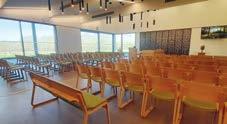
After following up the idea with extensive research, liaison with a consultant from the industry and a feasibility study. A need had been identified and it was time to take this further by pulling together a business case and making the idea become a reality. Once approval was granted for the business case it was full steam ahead.
The build of the crematorium started in November 2021 and took 16 months to complete with many hurdles to overcome along the way but with perseverance and a proactive contractor Rushcliffe Oaks opened its doors for the first services on the 3rd of April 2023.

The building was designed to blend into the landscape and the planted roof certainly helps it do that. Since the build completed the site has been filled with nature including some that like to join in with the services by either strolling past the window or having a little look at their own reflection which always raises a smile during a difficult time.
The Manager of Rushcliffe Oaks Rhonda Churchill was appointed at the very beginning of the build process and along with the rest of the team Clare Browne, Anthony Wilkins and Andrew Mark who were recruited at various points during the build phase, have been integral in ensuring that all the operational workstreams were completed and ready to go in time for opening. This has given the team the opportunity to be involved every step of the way and on many occasions influence some of the decisions taken.
We offer six services a day with a generous gap in between to give families plenty of time without feeling rushed.
Since opening the doors in April, we have had the privilege of welcoming families who have chosen to trust us with their loved ones and have received positive feedback including testimonials, cards and gifts.
Moving forward we want to build on a positive start as we develop the site further whilst maintaining the high standard already set.
Every service is different, and every family has a different idea of what they would like for their family members final journey. At Rushcliffe Oaks we have a flexible approach and have so far accommodated many different requests. This is an approach we look forward to continuing. It’s really nice to be able to adapt to the wishes of families and make the experience as good as it can be at such a difficult time.
The ICCM Journal | Autumn 2023 | V91 No. 3 19
Rhonda Churchill, Rushcliffe Oaks Manager
Industrial Cleaning & Maintenance Specialists for Crematoria







CLEAN, SAFE, EFFICIENT AND HEALTHIER WORK ENVIRONMENTS











HAZARDOUS DUST REMOVAL
DEEP CLEANING SERVICE

POST WORKS HEAVY CLEANS

whatever happened to manners?
“Times they are a-changin” sang Bob Dylan and they certainly were and have continued at a pace. This is evident in the world of bereavement where we have embraced technology across the service. When I started off in my career working at a funeral directors, prior to swapping sides, most funerals were led by ministers with a distinct religious tone to them, often with an organist and hymns too. I remember all too well the record player in the music room, soon to make way for cassettes and in time, cd’s and then digital downloads. Visual tributes and personalised services and the religious symbols removed or covered on request.
The computerised records and databases assist in the administration and genealogy searches and grave details. The online booking services and companies providing music and visual services make the service booking and planning so much easier for funeral directors and families. Memorialisation has expanded with many different options available to families and the use of social media to promote it. We have certainly embraced this new world and tried to make an all-encompassing service provision within our crematoria and cemeteries.
So, when we look at the changes we have implemented and how this has boosted the service provision to all our stakeholders, why does it feel like we are always under scrutiny? We have always accepted and acknowledged that the bereaved will take out any pain, anger, hurt, regrets and frustration of their loss, firstly with the doctors and hospitals, then with the funeral directors and finally with ourselves. The only difference with these three sectors is that we are the only sector who really remain as a constant for families and who are always available to them when they want anything due to our overriding responsibility of being public servants. On many occasions, we have experienced issues with families getting magnified and exaggerated but we accept this as a stage of the grieving process and invariably often take the hit giving families far more opportunity to vent, and we soak it up knowing that it is not personal. Nowhere else within our organisation does this happen.
At what point does this acceptance and allowance for grief cross the boundaries and just become bad manners and bad attitudes mixed with a lack of respect? The more we have given people the more they want and demand.
A tirade about flowers and ornaments removed from a grave, only to later learn there is a major family dispute going on yet no apology for the accusation. The blatant flaunting and disregard to cemetery regulations with kerbs, stones and other unauthorised items impeding neighbouring graves and any talk about removing them is met by intimidation and threats of violence. Families placing security cameras in trees and turning up mob handed if they think anyone is tampering with anything on
their grave. We totally understand that everyone grieves in their own way and one man’s treasure is another’s trash, but when it impinges on other grave owners and causes maintenance issues, shouldn’t we be able to uphold the regulations to enable parity and ensure the area is maintained as expected? Cars parking on graves and then when challenged, to be met with abuse because people think they are entitled to park as close to their grave as they can. Dog owners politely being asked by staff not to allow their dogs to dirty on graves or remembrance gardens but instead of being sorry and offering apologies they verbally attack staff with a string of obscenities and expletives.
I visited two cemeteries on Christmas Eve and carnage is probably the best word to describe what I found. Cars parked all over the place blocking exit routes, people dragging benches across sections to decorate near their grave, arguments between families. Another group smashing a fence to gain access from the meadows into the cemetery, dogs running loose etc. A time of peace and goodwill it definitely was not! Frustrated and confused by the attitude of people only interested in themselves and doing their duty, I quickly made my way home. On Christmas morning members of the local church come to the crematorium giving free tea and coffee to visitors. This is a tradition I now join in and three hours spent sharing a brew, a mince pie and a friendly word with people shows me the true spirit of people. All the clamour of the day before seems lost as, once again, the caring and sharing spirit of the service shone through and for that time, people accept it in the true nature it is intended.
The whole of society is represented in a cemetery or crematorium. The rich and the poor, the notorious and the anonymous, laid to rest side by side, each remembered by the words written on a memorial. In life, they were the proverbial masters and servants, each needed the other to survive. In death they are all equal and deserve to be treated with dignity and respect. As custodians, we have a duty to manage this heritage, encompassing change in its many facets and pass it on to the next generation. We contribute to the rich tapestry of life and death and are there for those who use our services, whether on a daily basis, an annual visit or whenever they feel the need.
We are a select band of people who have found a vocation that is so special and ultimately rewarding despite however hard it feels at times. However, the frustrations of life and death have to find a way out and whilst we will never change the attitude of people, we should not be expected to bear the brunt of their frustration.
David Jennings Bereavement Services Manager Altrincham Crematorium
The ICCM Journal | Autumn 2023 | V91 No. 3 21







22 The ICCM Journal | Autumn 2023 | V91 No. 3
iccm recycling of metals scheme

Press releases and statements for awards made in March 2023 for the October –March 2023 donations. Each nominated crematorium was awarded £12,000 to their cause(s).

Leeds
A fantastic £6000 has been presented by Chris Simpson, Bereavement Services Manager at Leeds City Council, to the Leeds based charity Martin House Children’s Hospice who provide family-led care for children and young people across Yorkshire with life limiting illness. The money is generously donated from the recycling of metals scheme managed by the Institute of Cemetery & Crematorium Management to which Chris nominated Martin House Hospice, who are one of the current chosen charities of the Lord Mayor of Leeds.
Alongside Cllr Salma Arif, The Lord Mayor was delighted to attend the presentation that took place at the Civic Hall. He has been actively fundraising for Martin House throughout his mayoral year to enable families to access their vital services. The Lord Mayor of Leeds, Cllr Bob Gettings said: “I cannot thank the Bereavement Services Team enough for their assistance in securing this donation from the Recycling of Metals scheme. Martin House Children’s Hospice provide an invaluable service for children and young people across the city and the wider area.”

“Understandably this is a very distressing time not only for the children, but for their families and loved ones too and Martin House Children’s Hospice are able to offer them support in so many ways.”
“Martin House Hospice rely solely on charity funding to enable them to continue with their amazing work and so I would encourage both businesses and individuals to support this very worthwhile cause.’’
Councillor Salma Arif, Executive Member for Public Health & Active Lifestyles, said: “I’m grateful to the Institute of Cemetery and Crematorium Management for their ongoing support to our local charities, through the Orthometals Fund.
“I’m delighted that Martin House Hospice were selected this year, as they provide such a valuable service to people at their hour of need.”
Duncan Brownnutt, Regional Fundraiser at Martin House Hospice told us “We are absolutely delighted to receive this donation which will help us to continue to provide specialist care to seriously ill babies, children and young people with life-limiting conditions. This support will make a real difference to the families who need the care of Martin House.”
More information about the charity can be found on their website www.martinhouse.org.uk
The ICCM Journal | Autumn 2023 | V91 No. 3 23
Left to right : Cllr Salma Arif, Chris Simpson, Duncan Brownnutt, The Lord Mayor of Leeds Cllr. Bob Gettings.
South Ayrshire
THOUSANDS of pounds have been donated to help former service personnel thanks to a novel recycling scheme at an Ayrshire crematorium.
South Ayrshire Council has donated £12,000 to the Royal Air Force Benevolent Fund - thanks to metal implants recovered and recycled from Masonhill Crematorium.

This donation was made possible thanks to the generosity of bereaved families who allowed metal implants to be recovered and then recycled, following cremations.
The council is a member of the UK Crematoria recycling metals scheme, which means that with the permission of the deceased person's family, any metals recovered can be recycled and the money used to support charities.
The RAF Benevolent Fund has been instrumental in supporting serving and ex-serving RAF personnel and their families in need since its inception in 1919, providing lifelong practical, emotional and financial support.
They are also the council's event charity partner for the upcoming International Ayr Show – Festival of Flight. South Ayrshire Council’s Provost, Iain Campbell, said: “The RAF Benevolent Fund provide fundamental support to our RAF veterans and rely on donations to provide their services. I’m delighted that this donation will make a difference to their operations in South Ayrshire.”
Councillor Martin Kilbride, the local authority's portfolio holder for buildings, housing and environment, added: “The generosity of the families is very much appreciated, and we are thankful that even during their time of grief, they have thought about others.”
Gavin Davey, director of the RAF Benevolent Fund for Scotland, Northern Ireland and North-East England said: “We are delighted to be partnered with South Ayrshire Council to reach and support RAF veterans in need.
"This kind donation will support personnel and their families in South Ayrshire, and help us to reach even more.”
For more information on the RAF Benevolent Fund, visit www.rafbf.org.
Wrexham
'Every donation makes a huge difference!'
Thank you for your kind donation of £6,000.00 for Nightingale House Hospice. Please accept this letter as a receipt of your donation.
Thanks to your donation, the hospice can continue to deliver the specialist care to adults in our community affected by life-limiting illnesses. We also support any child who needs the hospice's bereavement support service, even if they do not have links with the hospice.
A New Service -The Nightingale Wellbeing Centre
The Day Services Unit has been rebranded to the "Nightingale Wei/being Centre". The new name will better reflect the type of support that we offer to patients who have a life-limiting illness. As part of this, we are offering a Wei/being Programme which will provide:
• The opportunity for patients and carers to meet others in a similar situation, building companionship at the most difficult of times.
• Access to professional and individualised advice and support; emotionally and practically
• Access to other services including physiotherapy, complementary therapy, and family support.
Thank you! Diolchl You have made a real difference to the lives of others, making it possible for our hospice to continue doing its fantastic work, providing much-needed care at the most difficult of times.
To keep up to date with the ways you can help or support, please visit www.nightlngalehouse.co.uk
We would like to keep in touch with you about our work, future fundraising activities and ways you can get involved. You can opt out of hearing from us at any time by calling 01978 314292.
With our best wishes, The Fundraising Team at Nightingale House Hospice.
24 The ICCM Journal | Autumn 2023 | V91 No. 3
Reading
Reading crematorium has donated the huge sum of money to Team Charlie, a charity that was set up in memory of 13-year-old Charlie Ilsley, from Caversham, who died from a brain tumour in 2020.


The money was raised by Reading Crematorium’s recycling scheme that sees them selling and recycling metal body parts. The charity said they didn't expect to receive so much money.
Trustee of Team Charlie, Claire Brown, said: “They had approached the charity towards the beginning of the year stating their intent to donate something in the coming months, we thought this was a lovely gesture but assumed this was a lot smaller donation, perhaps around £100 if we were lucky.
When Gerri called me in March from the crematorium to confirm the monies would be paid and she confirmed the actual amount, I had a huge lump in my throat and almost dropped the phone in shock.
“This is an unbelievably kind gesture and a stonking amount of money which we never dreamed we'd get and will help to support many children living with brain tumours across Oxon and Berks.”
Charlie Ilsley was diagnosed with a medulloblastoma aged eight and despite £33,000 being raised to pay for overseas treatment, he passed away in December 2020.
His mum Toni and her cousin Karen Williams set up Team Charlie, which aims to support other local children with the same illness.
Claire said the recycling scheme is “a brilliant idea which not only benefits charities but is environmentally friendly.”
“We are indebted to the families of those who have passed and hope it offers some small comfort that something positive has come out of such a tragic loss.
“We also can't thank the crematorium enough, it's truly wonderful. It was also where Charlie's service took place, so this is tinged by so much poignancy. His legacy lives on.”
If you’d like to donate to Team Charlie, go to: www.teamcharlie.org.uk. 100% of donations given will go directly to the children and families involved.
Swansea
The ICCM Journal | Autumn 2023 | V91 No. 3 25
South West Cancer fund presentation, Lyndon Elsey of Swansea Council and Cathy Stevens on behalf of the charity
Bromsgrove and Redditch
A CHARITY which provides support to bereaved children across North Worcestershire has received a £12,000 donation. Thanks to Redditch Crematorium, Touchstones Child Bereavement Support received the funding boost to continue its work with young people.

Touchstones Child Bereavement Support was nominated by Redditch Crematorium to receive the funding as part of the Institute of Cemetery and Crematorium Management metal recycling scheme.
Residual metals – such as in replacement hips – are then recycled at the crematorium, with money raised then donated to charity.
Touchstones is a small, charity with one very simple aim – to be there for any bereaved child and young person.
Rob Quarton, director at Touchstones, said: “For over 11 years Touchstones has been privileged to provide bereavement counselling support to any child or young person in Redditch and Bromsgrove who has lost a mum, dad, brother, sister, grandparent, friend, or any other significant person.
“We work with around 150 children each year, and since our support is offered without cost, we totally rely on fund-raising and donations to enable us to continue.
“The support we receive from both the ICCM and Redditch Borough Council has and continues to be a significant and valued enabler of all we do, and we are so immensely grateful for this latest, incredible donation.”
Redditch Borough Council leader Coun Matt Dormer, said: “A huge thanks go to Touchstones for providing this incredible and selfless support service.
“We are proud to nominate them to receive this money so that they can continue supporting our younger residents.
“Grief is difficult for an adult to process, but for a child it can have such a significant impact on their mental wellbeing and future development if left unchecked.
“It is comforting to know Touchstones will be able to continue supporting children and young people as a result of this funding.” Visit touchstones-support.org.uk/ for more information.
Coychurch
Alzheimer's Society
Like you, people are at the heart of everything we do. A huge thanks to all the amazing people at Coychurch Crematorium who have today, shown that when we work together, we can achieve such amazing things. Thank you for partnering with us and investing in our cause with a generous donation of £12,000.00. We will ensure that we make every penny count to drive our crucial work.
The number of people with dementia is increasing dramatically, with numbers set to reach one million by 2025. That's why our work is so urgent and why we're backing the world's brightest minds and funding over 600 research projects to find the best ways to_get early diagnosis, innovate care and develop targeted treatments.
We'll make sure your donation is put to good use, whether it's spent QJ campaigning governments to make dementia the priority it should be, or delivering vital services across the UK. You're making a huge difference.
Together we are help and hope for everyone living with dementia. Once again, thank you.
Yours sincerely
Yassen Hadjiamin Fundraising & Marketing Support Administrator ENC ½
26 The ICCM Journal | Autumn 2023 | V91 No. 3
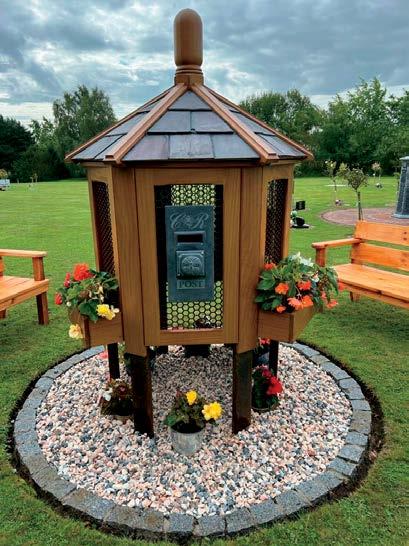

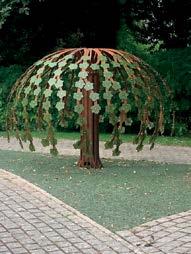


T E L : 0 1 4 8 2 3 8 7 4 6 6 E m a i l : c a r a l o f t @ o d l i n g s c o u k 5 9 N E W C L E V E L A N D S T R E E T , K I N G S T O N - U P O NS e
v
o u
c o m m u n i t i e s , p r e
e s . B E S P O K E C R E M A T O R I U M A N D C E M E T E R Y D E S I G N S O L U T I O N S T E L : 0 1 4 8 2 3 8 7 4 6 6 E m a i l : c a r a l o f t @ o d l i n g s c o u k 5 9 N E W C L E V E L A N D S T R E E T , K I N G S T O N - U P O N - H U L L S e r v i n g o u r c o m m u n i t i e s , p r e s e
n g o u
m e m o
i e s . B E S P O K E C R E M A T O R I U M A N D C E M E T E R Y D E S I G N S O L U T I O N S
r
i n g
r
s e r v i n g o u r m e m o r i
r v i
r
r
DESIGNED FOR YOU








Epilog Sequel 3.1 consists of a powerful core system and a robust, flexible collection of optional modules that service all aspects of cemetery and crematorium administration.
You choose the modules that you need.

Legally compliant, comprehensive registers of cremations, burials, and disinterments
Online booking for funeral directors





















Mapping and memorial inspections

Management of leases and renewals for graves and memorials


Epilog Sequel's comprehensive core system caters for every task. With Epilog Sequel installed, you won't need another programme. Maintain legally compliant records, send headed letters, make service bookings in the diaries, generate invoices and reports, create work orders; manage all of your day to day task in one place.




Support for our users, support for our system. Our experienced, helpful, and professional technical team are here to support you throughout the working day, contactable by email or phone. Our developers are constantly improving Epilog Sequel and our system is regularly updated and patched.


Backed up and secure. Should you choose to host your system with us, your data will always be backed up and kept secure.
Head Office: 01536 791 568
www.gowerconsultants.co.uk


Technical Support: 01273 782 057





gower@manuscripti.net
The Elms Studio, Isham Road, Pytchley, Northamptonshire, NN14 1EW
Epilog Sequel 3.1, the most powerful and flexible administration system for cemeteries and crematoria
bariatric funerals
Tackling a big issue
Our population is growing, in more ways than one. Since 1993, the percentage of adults classed as overweight or obese has increased from 52.9% to 64.3%. The Health Survey for England 2021 (published December 2022) estimates that 25.9% of adults in England are now obese (BMI >30) and a further 37.9% are classed as overweight (BMI 25-30).
The funeral industry services the final part of the life cycle, and the impact of our growing physical size is becoming increasingly evident in the way we need to prepare for, and manage, our funeral services.
Sometimes, the initial act of transport can be difficult, and larger loading equipment and associated supplies are just a part of the preparation needed. Uprated vehicles suitable to transport a larger person will surely become an essential asset for funeral directors, cemeteries and crematoria alike.
When planning a ceremony, the combination of larger caskets (and the increased popularity of the already heavier American-style ones) plus larger loads, often means that it becomes impossible for pallbearers to manage the load safely, so alternative means must be found. Larger trolleys with significantly uprated loads become extremely useful in ensuring that the casket is handled delicately and safely, with minimal impact on the ceremony.
At crematoria, larger cremators have been on the market for a while (steadily increasing in size availability), and when these are installed, they need to be paired with suitably uprated load-bearing transfer equipment, such as trolleys and biers.
However, sometimes the availability of larger cremators locally, or their size limitations, mean that families are faced with being unable to proceed with a planned cremation for their loved one.
When this occurs, there is no alternative but burial. This can cause some problems for cemetery managers, as our often-historic cemeteries and burial grounds were not planned out with a much larger population in mind!
Finding larger plot sizes is often difficult and where they can be accommodated, it is usually at the expense of the midwall between graves. An average midwall (or midfeather as some may know it) should be between 12-18 inches, and many of our risk calculations are based on this. Excavating a plot with a decreased midwall can literally mean digging into your safety, as the risk of collapse increases significantly.
Richard Smith, Operations Director of Teleshore, said: “We have been working with several of our cemetery clients to support them with the increase in bariatric funerals. Working through the cemetery risk assessments with them, helping with method statements to suit, we have begun manufacturing equipment that mitigates many of the increased risk areas.
We have supplied larger sets of grave shoring and have put into production a series of associated tools, such as trolleys and lowering devices, which can handle significantly higher loads.
Talking to our industry peers, it’s not something that any of us want to be doing on the backfoot, and we need to factor this into any equipment planning cycles.
The last thing anyone wants to do is have to an accident, injury or worse even a delay to a funeral because we don’t have the right equipment to do it safely.”
Richard Smith Teleshore Group
The ICCM Journal | Autumn 2023 | V91 No. 3 29
dead good words
Our manifesto for change
The way we talk about death affects the way we treat people who have died and their family and friends. Founder and Chair Poppy Mardall argues that it’s time for us to find better language that works for all of us.
In the UK, when someone dies, we 'dispose' of them. ‘Disposal’ is a legal and technical term which has been used for over one hundred years to describe what happens to our bodies after we die. And it’s still being used today.
The definition of ‘disposal’ is “the act of getting rid of something, especially by throwing it away” – it’s another way of saying “chucking, scrapping, dumping, ditching”. Using the word ‘disposal’ implies that we don’t care much about our dead people. It’s an odd, and damaging, word to use to describe the care I think we should be taking when seeing our bodies to their final destinations.
Time to change the dehumanising language
There are other words that we use to talk about death which, when you stop and think about them, are outdated, unhelpful, and even downright offensive.
When we die, we immediately stop being referred to by name – we become 'the deceased'. In that moment of death, we lose our gender, our identity and our personhood. When the funeral directors collect us from wherever we have died, they call it a 'removal'. Like, 'I'm going to come and remove your mum from her house.'
You might be asked if you’d like to ‘view’ the person who has died, as if you were going to look at a flat or test drive a car, rather than visiting or spending time with that person, just as you might have done when they were alive. This dehumanising language shapes our attitudes and treatment of those who have died. And, because we will all die and we will all grieve, it impacts all of us.
Words have power
The words we use to describe what we do shape how we do it.
As a funeral director working to bring gentleness and thought to the process of caring for the bodies of people who have died, I see how using the word ‘disposal’, and other similar terms, helps to shape uncaring and thoughtless attitudes towards the dead.
Over the 11 years I have been working with dead people, media exposés on death care have kept coming. These exposés show inhumane, production-line treatment of the dead. It feels to me like people are being thrown away, chucked, scrapped, dumped and ditched.
Mortuary workers, like anyone else, want to feel that their
work matters. We need to validate their work as care — as looking after people, not disposing of waste.
If you give people language, role-modelling, and emotional and practical support to do their jobs with care, gentleness and attention, that is what they will do.
Poor care for the dead is grim for workers, it’s traumatising for friends and family at the moment when they most need support and healing, and it’s destructive to the planet. But it doesn’t have to be this way.
#DEADGOODWORDS - Finding new language Language sets expectations and shapes attitudes. It can and should evolve, as society changes and evolves.
Many grim words have been thrown out of use once people said, 'this word is doing harm, this word is not serving us, please can we find a new one?'
We know it’s possible. Language around disability, race, gender, mental health and sexuality has changed dramatically in the last fifty years.
Today, it’s time to find neutral and correct language that returns the humanity to caring for the dead — language that will raise expectations and lift standards.
Some alternatives already exist. Others we need to create together.
No funeral director would ask a grieving family which disposal method they would prefer for their mum, brother, friend or child who has died. Instead, we talk about individual choices – burial or cremation. At Poppy's, we are also trialling a new word that we think works: reposal.
We have found accessible, humanising language to talk about the work we do to support the living and care for the dead. We use this language every day and are delighted to share our ideas in the #DeadGoodWords manifesto.
This is the start of the conversation. For change to happen, we need you to add your voice and your experience. We’d love to hear what you’d like to change and your alternatives. Please share these using the hashtag #DeadGoodWords. It was first published on www.poppysfunerals.co.uk/talkingdeath which you can follow on @poppysfunerals for the latest #DeadGoodWords campaign updates and more.
Together, we can create new, better ways of talking about death that make people feel respected, cared for and understood.
Poppy Mardell
30 The ICCM Journal | Autumn 2023 | V91 No. 3
soil management and drainage in cemeteries
On 7th March the ICCM held a Soil Management and Drainage in Cemeteries seminar, sponsored by the CDS Group at Kents Hill Park Training and Conference Centre in Milton Keynes.
The seminar was aimed at all those with responsibility for or working in a cemetery and featured advice on how soil should be managed in cemeteries, an understanding of what soil is, and the latest developments from the Environment Agency on ground water protection in cemeteries.
Julie Dunk, CEO of the ICCM, introduced the event, outlining the programme and objectives for the day, followed by Justin Smith, Managing Director of the CDS Group who outlined the work CDS are undertaking in the bereavement sector from ground water monitoring to helping develop new green cremation technologies.
The next presentation was delivered by Paul Doherty a National Senior Advisor in Groundwater at the Environment Agency with over 30 years’ experience as an environmental regulator. He is the national technical lead for groundwater quality and protection, permitting and compliance matters under the Environmental Permitting Regulations. He works closely with DEFRA and regularly provides strategic technical advice to the government on a range of groundwater protection issues.
Paul started by explaining why groundwater protection is important. Groundwater is at the heart of the water environment, and it is fundamental in supporting many of the “on surface” water features and their dependent ecosystems that people care deeply about e.g. providing baseflow to rivers and watercourses and other wetland habitats. A clear example of this can be seen with chalk streams and the habitats such pristine rivers support – that water is in effect groundwater rising through the bed of the river. If we don’t protect the quality of groundwater discharging into chalk streams, we will significantly damage or even loose these habitats.
Over 30% of public drinking water supplies in England are abstracted from groundwater, rising to over 70% for much of the South and East of England, plus the 10,000’s of private supplies that isolated homeowners rely on for their drinking water. It also directly supports agriculture, food manufacturing, brewing, industry and a host of other uses.
However, groundwater is vulnerable to pollution and once polluted it is hard and expensive to remediate. Many activities can lead to the pollution of groundwater including agriculture, urban drainage, landfills, petrol filling stations and cemeteries. Too often groundwater is considered to be “out of sight, out of mind” but the aim is to try and change that perception and in terms of potential polluting activities the Environment Agency take the view that “prevention is better than cure”. The Environment Agency (EA) has a statutory responsibility for managing and protecting England’s groundwater and they are required by DEFRA to regulate, plan, monitor and advise others to balance the needs of water users and the environment and protect it as a resource for future generations.
They apply a risk based and proportionate approach to regulation of all sectors and activities that can potentially impact groundwater quality.
Application of this approach can be seen in a number of publications, particularly: “The Environment Agency’s Approach to Ground Water Protection” and the various guidance documents they have produced which can be accessed via the “Groundwater Protection” ‘landing page’ on Gov.UK. https://www.gov.uk/government/collections/groundwater-protection Cemetery burials are ‘groundwater activities’ (GWA) under the Environmental Permitting Regulations 2016 (EPR 2016).
As a GWA the Environment Agency are required to ensure all necessary measures are taken to prevent the input of hazardous substances to groundwater and to limit the input of any non-hazardous pollutants to ensure any inputs do not cause pollution.
For many years they have not utilised their powers for permitting cemetery sites, and have instead managed the environmental risks to groundwater and surface waters via the Town and Country Planning regime, i.e. held the view that pollution control would be most appropriately achieved by influencing the planning system to direct development into areas of low risk to groundwater.
However, in recent years leading up to the Covid pandemic they have increasingly seen development proposals to build or extend cemeteries into areas of higher risk to groundwater due to space constraints. Proposals for novel burial techniques and increased burial density are also becoming more common. This is especially a problem in the south- east where the population density is the highest and large swathes of the countryside fall within groundwater source protection zones or other sensitive areas.
The ICCM Journal | Autumn 2023 | V91 No. 3 31
The EPR 2016 are the Agency’s principal legislative means of protecting groundwater. They provide the EA with the legal mechanism to ensure groundwater is appropriately protected by means of applying environmental controls via permits and exemptions. It is a risk-based hierarchy of regulatory approach.
For activities that pose high risk to the environment, these require bespoke permits in order to ensure the right controls (via permit conditions) are in place to allow that activity to be undertaken lawfully. Bespoke permits require an appropriate level sitespecific risk assessment to accompany an application.
Where an activity still requires some operational controls but due to, for example, it’s location in a less environmentally sensitive area and/or because the activity itself is deemed to be less of an environmental risk, then those controls can be applied in a standard, more generic manner. This “middle tier” can be considered under a Standard Rules (SR) permitting approach. SR permits are much cheaper to obtain and much less complicated than a bespoke permitting approach and no site-specific risk assessment is needed as a ‘generic risk assessment’ has been used to design the conditions in the SR permit itself.
For ‘low risk’ activities, exemptions from both bespoke and SR permitting can also apply, whereby no permit is required provided the operation of the activity can meet the exemption conditions. Exemptions are also free.
Since April 2022 (and specifically after the pandemic was over) they have therefore introduced a bespoke permitting approach for HIGH RISK cemetery developments. This applies to new cemeteries and proposed expansions of existing cemeteries into effectively new geographical areas that need new planning permission under s.57 of the Town and Country Planning Act 1990.

HIGH RISK means:
• it presents a high risk to the environment due to its proposed location;
• the development needs active pollution prevention mitigation measures or operational burial controls to protect the water environment;
• the Environment Agency told you during the coronavirus pandemic that you would need to apply for a permit; or
• you submitted a planning application on or after 1 April 2022 and the Environment Agency told you that you would need to apply for a permit
This is detailed further on the Gov.UK page “Protecting groundwater from human burials” https://www.gov.uk/government/ publications/protecting-groundwater-from-human-burials/protecting-groundwater-from-human-burials
Currently however, they have no legal mechanism of applying where necessary lesser regulatory controls to cemeteries that are not deemed to be high risk.
For the future they need a risk based, proportionate regulatory regime that covers all new cemeteries from those presenting the highest risk to the environment, to those of lowest risk. EPR 2016 does provide such a framework, but legislative changes are needed to the ‘groundwater activities’ aspects of EPR to legally bring that about.

Defra consulted publicly towards the end of 2021. The consultation proposed a range of amendments to groundwater activities under EPR 2016, including providing the EA with the ability to use Standard Rule permitting approaches and activity specific exemptions, one of which obviously was for low-risk cemeteries. Both DEFRA and EA were very conscious of concerns raised during the consultation period, particularly in relation to exemption conditions applying to both existing and new cemeteries.
The government’s response to the consultation on amendments to the EPR 2016 as applied to groundwater activities and related surface water discharge activities has now been published. A full copy of the report can be found on the government’s website https://www.gov.uk/government/consultations/groundwaterand-surface-water-discharge-activities/outcome/summary-of-responses-andgovernment-response
Under the amended proposals, existing cemeteries won't be affected, although they will be expected to follow the current Minimum Good Practice Groundwater
32 The ICCM Journal | Autumn 2023 | V91 No. 3
Protection Requirements. New cemetery developments and cemetery extensions that require planning permission on or after the date on which the updated regulations come into force will have to comply with the amended regulations. This means that they will require either a bespoke permit if they are deemed high risk, standard rules permit if they are deemed medium risk, or no permit if they can comply with the exemption conditions and are deemed low risk.
The revised proposed amendments to the Environmental Permitting (England and Wales) Regulations 2016 will be laid before parliament as and when Parliamentary time allows.
The next segment, Managing Water in Cemeteries, was delivered by Alex Vickers. He gave us an introduction to soils and how water flows through them. He explained that soil particles can be different sizes and textures; sand which has a gritty texture, silt which has a soapy texture and clay which has a sticky texture, all of which influence how water drains through them and therefore will affect the drainage in cemeteries.
Alex used visual props and experimental style techniques to explain what happens to water when filtered through different types of soil, and how having an understanding of your soil type, will enable you to build better, more effective drainage systems.
The paper also covered the causes of poor drainage, how water travels in relation to gravity, the migration of water from adjacent land and run off and drain flow attenuation. Attenuation is the process of storing and releasing surface water run-off and is one of the key features of sustainable drainage systems. He covered different types of drainage systems (one size doesn’t fit all!) which also detailed poor drainage practices. I think a few people recognised some of the photos shown as examples as being indicative of their sites. It was an opportunity to get some valuable advice and share common issues faced by a lot of cemeteries.
Alex’s presentation was comprehensive and informative but delivered with such enthusiasm it was not only infectious but made a complicated subject fun.
Justin Smith followed this with a paper on water pollutants in cemeteries and ensuring healthy soil. The impact on ground water from polluting chemicals and pathogens from human cadavers are related to your soil’s classifications and their management. Justin showed how a basic understanding of your soil chemistry will ensure you reduce the effects of burial contamination from your cemetery. He also looked at soil nutrition and what causes toxicity from cremated remains on plants and how the quality and health of your soil can be improved. He explained comprehensively how soils are the first line of defence in protecting groundwater.
Did you know….
• One teaspoon of soil contains 10 billion micro-organisms
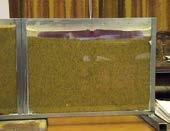
• There is sufficient DNA in 1 gm of soil to extend 1,598 km
• 25% of living beings on earth live in the soil
• Soil is technically a living entity


• 95% of all food production relies on soil
• It takes 500 years to produce 25 mm of topsoil

• Topsoil is a nonrenewable resource
• Topsoil is depleting 4 x faster than its being regenerated
The ICCM Journal | Autumn 2023 | V91 No. 3 33
Perched
Fine soil
Callum Ward is the Principle Engineer for CDS with over 12 years experience in the site investigation industry, undertaking a wide range of contaminated land and geotechnical assessments on various sites including residential developments, commercial properties and brownfield land. He also has background in waste classification work.
Callum, normally seen in a middle of a muddy field, swapped his boots for the classroom to present his paper on cemetery waste management.
Operational burial facilities across the UK all have one thing in common, they produce excess burial arisings during their operational processes, which requires temporary storage on site prior to subsequent offsite disposal to a licensed landfill site.
Many burial sites across the UK treat burial arisings as a material to be ‘lost’ on site in order to reduce operating costs and help to reduce the cost of burial plots to the wider public. However, the construction/formation of mounds/bunds or the infilling of areas on the site, without an approved material management plan, is considered to be illegal landfilling and sites could be prosecuted by the Environment Agency and fined by HMRC.
Excess burial arisings need to be disposed of in line with the current guidance. As part of this, it is the waste producer’s responsibility to appropriately classify the material prior to offsite disposal to ensure the material is sent to an appropriately licensed landfill. Alternatively, if the burial arisings can be used for a valid purpose within the grounds on the existing cemetery, then the works can be managed under an approved material management plan.
The paper went into details about waste classifications and how to manage soil in a legal and profitable way.

The last paper entitled Planning New Cemeteries was delivered by Ben Copeland. Ben has over 5 years of planning experience with CDS and manages planning projects and applications for crematoria, cemeteries and sports grounds. He has a critical understanding of national and local planning policy and the requirements to achieve a successful planning application and project outcome. The presentation covered the planning process in relation to suitable site selection and the environmental implications from a planning perspective.
The Environment Agency regulations cover developments from 1 April 2022 which require new planning permission under section 57 of the Town and Country Planning Act 1990. The guidance applies to proposals to develop a new cemetery or expand an existing cemetery.
Ben explained the levels of assessment and degree of studies required when planning a new site. He outlined the environmental considerations that need to be taken into account such as groundwater depth, groundwater source protection zone, superficial geology, bedrock geology, flood risk and landfill. Under the Environment Act 2021, all planning permissions granted in England (with a few exemptions) will have to deliver at least 10% biodiversity net gain from an as yet unconfirmed date.
He went on to talk about cemetery extension planning and when it is required in relation to extending an existing site. If the area is beyond the geographical extent of an existing cemetery boundary then you would need to gain full planning permission, the same as if it were a new cemetery. If you are not sure you would need to conduct a historical data search which could result in either proceeding with the development in accordance with the original approved plans or submitting an application to differentiate from the approved layout, or if it is not clear, you may have to apply for a certificate of lawfulness. The benefits of a certificate of lawfulness, if approved, means you are covered legally for any burial operation on site, it removes the consultation of the Environment Agency from any application regarding burial use, and the site can operate under the same regulations of the existing site as it is not considered a ‘new cemetery’.
After several years of hosting virtual meetings and courses, this was one of the first face to face seminars we have held this year, and it was lovely to see so many members in attendance. Given the topic of discussion, you may be mistaken in thinking the day was going to be somewhat dry… or wet (pardon the pun). It was in fact, interesting and dare I say it… fun in parts (that could just be me!). It was so good to be able to network with others over a coffee and share experiences especially in a subject matter that may not sound exciting but one that is a constant headache to a lot of cemetery sites.
34 The ICCM Journal | Autumn 2023 | V91 No. 3
Allana
Sofia
CEMETERY SAFETY
THE EVOLUTION OF OUR CLASS LEADING SOFTWARE

Managing risk within a cemetery is critical. No matter how simple or complex your operation is, SAMM-Safety will provide you with the essential tools to satisfy H&S legislation and give you complete peace of mind.
Memorial Safety is the first module in the SAMM ‘Cemetery and Crematoria Management’ family. It is supplied with a central diary system, extensive administrative tools and a communication centre that provides a simple and effective desktop hub. The highly intuitive mobile application is designed to operate on any smart phone or tablet.
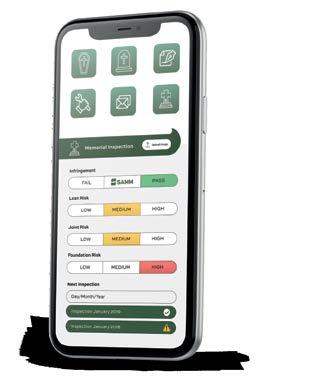
Memorial Safety is only the first step. We are developing scalable modules to satisfy the wider needs of your cemetery, including asset management, interactive mapping, maintenance of burial records and much more besides.

Early adopters will benefit from a low-cost entry point and the opportunity to influence the design and content of SAMM.
Early adopter prices from just £995 plus VAT



Cath Brew drawntoastory.com
For more information, visit SAMMsafety.co.uk
The ICCM Journal | Autumn 2023 | V91 No. 3 35
Powered by
Experts in memorial safety
Meet us at The ICCM Learning Convention and Exhibition 2023

Have you got cemetery safety questions that you would like some advice for?
Is there a product that would solve a problem for you, but you can’t find it anywhere?
Visit the Teleshore stand in the exhibition zone to ask us anything about cemetery safety and see our latest products on display.
Ask us about our new range of products to support bariatric funerals.
We can’t wait to see you!
NEW RANGE
Hessian textureD cremated remains boxes

• Natural, hessian effect, textured finish
• Manufactured in Britain
• Made using FSC certified, recycled paper sources
• Available in 3 natural colour tones
• Biodegradable and environmentally friendly
• More tactile than traditional boxes, appealing to those looking for visibly natural solutions
36 The ICCM Journal | Autumn 2023 | V91 No. 3
bringing the best to crematoria
TRUST IN TELESHORE - THE UK’s LEADING EXPERTS IN CEMETERY SAFETY.
Market-leading grave shoring solutions designed to keep your team safe and your cemetery operating within the law.

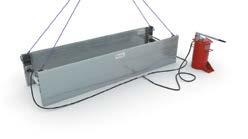
Contact us today for advice on the best solutions for your ground conditions.
Struggling to get everything done in-house? Our friendly team of memorial safety experts can support your cemetery team with memorial safety services.
Memsafe is fully BRAMM registered and offers:

• Cemetery Zoning
• Memorial inspections
• Memorial repairs
• Memorial renovation
• Supply of memorial safety equipment

The ICCM Journal | Autumn 2023 | V91 No. 3 37 Hydraulic shoring TELESCOPIC shoring & Cover SPEED Braces YEARS SERVING THE INDUSTRY 28 Don’t leave cEMETeRY safety to chance
Nationwide maintenance service for grave shoring equipment AVAILABLE NOW t: 01495 212 232 e: info@teleshore.com www.teleshoregroup.com
let’s talk about death
All children in England should receive grief education at school

About the research
Nearly all British children experience a bereavement by the age of sixteen. An estimated 16,100 children experienced the death of a parent from COVID-19 associated causes between March 2020 and February 2023. Through news and social media, young people are exposed to more conversations about death than ever before.
Yet, there is currently no requirement for schools in England to provide grief education and research suggests the topics are rarely taught. The statutory guidance for relationships, sex and health education (RSHE) only references bereavement as one of the common ‘adverse childhood experiences’ teachers should consider when they teach. Some schools may choose to use parts of the PSHE Association programme of study, which references ‘death’ or ‘bereavement’ at each stage of education, but these guidelines are not mandatory. Studies suggest that non-statutory topics – especially those that could be sensitive or controversial – are often not taught.
This results in a postcode lottery where many children have no classes on this universally relevant topic.
Unresolved grief can have a significant and lasting impact on a child’s wellbeing and has been associated with depression, anxiety and other psychological issues, as well as lower academic outcomes, substance misuse, unemployment, criminal convictions and suicide. It is essential that we equip young people with the knowledge and strategies to cope with grief and support others.
This policy report demonstrates the need to integrate grief education into the statutory curriculum in England, consolidating decades of research and campaigning by charities, families, teachers and academics and reflecting a key recommendation in the UK Commission on Bereavement’s landmark report (2022). The Government have committed to teaching about mental wellbeing at school. Learning about grief, death and loss should be part of this provision.
Key statistics for child bereavement in the UK
• Approximately 1 in 29 school-age children has been bereaved of a parent or sibling, an equivalent of one child in every class.
• A parent of children under 18 dies every 20 minutes. This equates to around 26,900 parents a year, leaving 127 children and young people newly bereaved of a parent each day.
• Many more children have been bereaved of a grandparent, other relative, close friend, or pet.
Key findings
Children who participate in dedicated grief education programmes are more able to discuss grief and less anxious about death. Evidence supports proactive grief education that allows pupils to learn about the topics outside of the context of a traumatic event and return to them in age-appropriate steps as they progress through school. Talking about grief can also help learners who are affected by other types of loss (including parental separation or friendship changes). Grief education would normalise the feelings of grief; help bereaved children understand, express and manage their emotions; and prepare other pupils to support their friends and classmates.
Children and young people are keen to learn about grief, death and loss in school. Nearly all of the 99 bereaved young people who reported to the UK Commission on Bereavement (2022) and the majority of the 31,000 others who participated in the accompanying VotesforSchools (2022) survey supported the idea of school-based grief education. They often recognised that death is a universal experience and that it would be helpful to learn skills to cope and support others even if the topics can be difficult to discuss. When a 2012 Ofsted survey asked 11–18-year- olds in England ‘which PSHE education topics they would like to learn about in school but currently did not’, ‘coping with bereavement’ was the most popular response. Although it is natural to want to protect children from upsetting truths, even very young children have a concept of death and benefit from talking about it and having their questions answered.
Adults in the UK generally support sensitive grief education. Some research into adults’ perspectives on grief education suggests children should learn about death and bereavement at home. However, the UK Commission on Bereavement (2022) found general support for school-based grief education amongst adults. Furthermore, when the YouGov (2021) ‘Daily Question’ for 16th March 2021 asked ‘do you think the subject of death, and issues around dying, should or should not be taught in schools?’, 67% of 4028 British adults responded ‘it should’, while only 13% responded that ‘it should not’. Even when studies identify the home as the primary place for death education, the participants do not necessarily object to learning about grief, death and loss in the classroom as well. In October 2022, John Adams, President of the National Association of Funeral Directors (NAFD), launched a petition to integrate compulsory death, dying and bereavement content into the curriculum. The petition received over 10,000 signatures and triggered a government response.
38 The ICCM Journal | Autumn 2023 | V91 No. 3
Childhood Bereavement Network
Image: iStock
Schools in England have access to a wealth of appropriate resources for sensitive teaching. Schools in England already have policies to engage with families about the content of sex education and religious education and offer parents the right to withdraw their child from parts of the curriculum. This approach could be extended to grief education, allowing teachers to communicate what will be covered and parents, carers and young people to ask questions and raise concerns. Sensitive grief education centres on generalised discussions rather than personal experiences, recognises religious and cultural differences, and allows bereaved pupils to opt out.

Charities and other organisations have produced a wealth of resources to support sensitive grief education for pupils of all ages and these have been well-received by teachers and other school staff in testimonials and evaluations. There is also a wide range of teacher training programmes available, but only a small proportion of educational professionals currently access the courses.
Curriculum change could also improve bereavement support in schools. While educational professionals often work incredibly hard to help their pupils, it is widely acknowledged that many staff at UK schools are insufficiently trained to support children and young people through bereavement. The UK Commission on Bereavement (2022) found significant disparities in the level of staff training and bereavement support available in different schools and different areas, with about a third of the bereaved young people surveyed reporting that they were ‘not at all supported’ by their education setting.
The teacher training that would be required for mandatory grief education could improve levels of bereavement support by increasing teachers’ confidence in talking to bereaved pupils, their ability to create a grief-aware learning environment and their knowledge of other services. Evidence demonstrates that empathetic and sensitive teachers can play a vital role in helping bereaved children manage their grief, especially as families are often grieving themselves. Increased knowledge about grief and bereavement may protect teachers too, helping them understand when a pupil needs more help than they can provide and facilitate appropriate referrals to educational psychologists, other professionals and support groups.
Mandatory grief education in schools may help instigate a wider cultural change. Enabling children to talk confidently and compassionately about grief, death and loss could normalise and destigmatise bereavement and grief, fostering the development of a kinder society. The organisations who reported to the UK Commission on Bereavement (2022) ‘highlighted the importance of looking forward when thinking about grief education, and how we can positively influence the next generation to offer understanding and compassion to those who will be bereaved’.
Recommendations
1. Discussions of grief, death and loss should be a mandatory component of primary and secondary relationships, sex
and health education in England. This will enable learners to talk about grief and death in a calm environment and return to the topics in age-appropriate steps. The core education programme can be supplemented with additional conversations when appropriate.
2. Discussions related to grief, death, and loss should also be incorporated into subjects like English, science, religious education and history and supported by wider school initiatives, allowing learners to explore different personal, religious, and cultural responses to bereavement and understand death as a natural part of life.
3. Teachers and other educational professionals should be offered training on how to start conversations about grief, death and loss, and integrate these topics into their teaching. This training could also give them confidence to support bereaved pupils more effectively, a widely acknowledged need amongst teachers.
4. Grief education should incorporate the wealth of resources and expertise which already exists in the UK.
Further information
The report is part of an ongoing collaboration between the University of Bristol, Child Bereavement UK and Childhood Bereavement Network, and sits alongside an openaccess article (https://bereavementjournal. org/index.php/bcj/ article/view/1082/1121), with supplementary file (https:// bereavementjournal.org/index.php/bcj/article/ view/1082/1122).
The research is funded by the Brigstow Institute, University of Bristol, the AHRC IAA Seed Funding Scheme, and the University of Bristol Faculty of Arts PGR Summer Internship Scheme. We would like to thank Julia Samuel MBE, Alexia MacDonald, Gail Precious, Dr Jane McCarthy, Dr John Holland, and SWW DTP for their invaluable advice and kind encouragement.
Contact the researchers
Dr Lesel Dawson: lesel.dawson@bristol.ac.uk
The ICCM Journal | Autumn 2023 | V91 No. 3 39
Dr Lesel Dawson, Rachel Hare, Dr Lucy E. Selman, Tracey Boseley, Alison Penny MBE, John Adams
A primary school class participating in a grief education lesson (‘Elephant’s Tea Party’, Child Bereavement UK)
From planning to completion, we’re with you every step of the way.
For over 20 years, CDS has pioneered the development of cemeteries and crematoria throughout the UK and overseas.
You may know us as Cemetery Development Services. We have rebranded and expanded but we have made sure we retained all the core values and expertise that enabled us to build our market leading reputation.
CDS are with you every step of the way from Feasibility Studies, Landscape and Concept Design through to Planning, Construction and Delivery, ensuring a seamless experience from inception to completion.

Our teams of highly qualified specialists - field surveyors, engineers and designers - are committed to creating beautifully landscaped
and thoughtfully constructed developments. Ones that have distinctive spatial qualities but that also offer excellent commercial value, and that are low-maintenance environments with minimal operational costs.
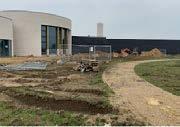
Our Green Agenda also ensures that our developments are environmentally friendly, offer reductions in emissions and pollution whilst helping improve biodiversity.
For more information on how The CDS Group can help, phone us on +44 (0)1525 864387 or visit our website.
Discover what’s beneath. www.thecdsgroup.co.uk Development in Progress – March 2021
lea fields crematorium
A demonstration to guests how they are being environmentally friendly at open day
Lea Fields crematorium opened its doors, giving people an opportunity to take an informal look around the facilities. Guests were welcomed by staff into the main chapel and offered the opportunity of a tour of the building, the garden of remembrance and the reflection pool.

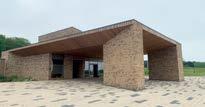
Staff members also showed guests how they are making their own wildflower notepaper from waste shredded paper and wildflower seeds. The public are able to use the seeded paper to write a private message to loved ones which are later soaked in water to begin the germination process before being mixed with compost and placed around the gardens.
Lea Fields crematorium is also a corporate member of the Institute of Cemetery and Crematorium Management (ICCM) Metal Recycling Scheme. Since 2020 they have donated £59,000 to various bereavement charities.
Deborah Balsdon, crematorium manager said: “The open day was very well attended, and we received lots of positive feedback. We appreciate it’s not for everyone. It’s a difficult time for families facing the loss of someone, but it’s clear that some people do find comfort in our transparency. Staff are very humbled by the positive comments received.”
Stephen Foley, managing director and second-generation craftsman of Hilton Studio attended the opening day and impressed visitors by demonstrating his talents with his personalised hand-painted entries in the Books of Remembrance.
Samantha Fairhurst, Senior Funeral Director at Cliff Bradley & Sons Funeral Directors Limited who attended said: “It was lovely to see so many people interested in the procedure at the crematorium. Questions are often asked, and by having the open day it demonstrates to people what actually happens ‘behind the scenes’. The grounds are beginning to mature, and the wildflowers are almost in bloom which look lovely.”
Refreshments were served throughout the day and guests enjoyed the gardens surrounding the crematorium which benefited from eye-catching views and glorious weather.
Gold award for council’s bereavement service
Lea Fields crematorium has received recognition for the service it provides to families at their time of loss. West Lindsey District Council which runs the facility in Lea near Gainsborough, has achieved the Gold standard in the Charter for the Bereaved Assessment Process following an in-depth assessment by the Institute of Cemetery and Crematorium Management (ICCM). The assessment process is designed to reassure service users that ethical and social standards have been adopted and met to the highest standard.
Councillor Trevor Young, Leader of West Lindsey District Council said: “It is important that families and friends receive the best care and support when arranging a funeral for loved ones. We are very pleased that Lea Fields crematorium has been awarded an industry gold standard which is a testament to the wonderful team.
“I would like to thank the team for all their hard work and the support they give to people during what is one of the most difficult times. We are committed to maintaining a high standard of customer care.”
The Charter for the Bereaved aims to promise members of the public that Lea Fields is committed in providing an excellent service that is responsive to meeting their needs. Issued by the Board of Directors of the Institute, the Charter also sets a standard of service in relation to burial, cremation, and funerals.
Deborah Balsdon, Crematorium Manager at Lea Fields crematorium said: “We are delighted that Lea Fields has achieved Gold Standard and strive to ensure our service meets the needs of families who are experiencing loss. We are passionate about the work we do and our dedicated team are committed to delivering the highest standards.
“We understand funerals are a topic that we don't like to talk too much about, but we believe it is important that people have access to helpful, knowledgeable staff and they understand the choices available to them when using such services. Our garden of remembrance and our book of remembrance room also offers people a place where they can reflect on loved ones in peace.”
For more information in the Charter for Bereaved visit the ICCM website: https://www.iccm-uk.com/iccm/charterforbereaved/
Katie Smith, Communications Officer
The ICCM Journal | Autumn 2023 | V91 No. 3 41

the cemeteries and crematoria group meeting

The Cemeteries and Crematoria Group comprising of managers from the East Anglia region, principally Essex, Suffolk and Norfolk held a rather special meeting last Tuesday 6th June at West Suffolk crematorium. After a welcome coffee and a pastry, the meeting got underway, chaired by Sue McDonald in the presence of some ten members. As always, the topics discussed were varied and interesting but the one that was subject of most debate was “what is the position regarding Medical Examiners”.
Mat Crawley and Alan Jos é were able to update the group on the progress or lack of it towards implementation and on the first stages of the work of The Commission for Burial and Cremation Law Reform. What is always interesting in meetings like this is the wide variety of different challenges faced by our colleagues across the region and there was much lively and interesting discussion.
Penny Stynes who has been the bereavement services manager at Colchester for some 20 years and the Chair of the Cemeteries and Crematoria Group for some 14 years is retiring very soon and this was to be her last meeting. Russell Gadsby has been appointed to the post of Bereavement Services Manager for Colchester and was in attendance.

Penny was thanked sincerely for her service to the bereaved during her career but especially for her unstinting work as Secretary of the Crematorium and Cemeteries Group. Several presentations were made to Penny and after lunch she cut a special cake made for the occasion by the West Suffolk catering team.
A big thank you to Claire Butcher the West Suffolk crematorium manager for organising everything for the meeting and Simon and his hospitality team for a lovely buffet lunch and the delicious cake and to the Westerleigh Group for sponsoring the meeting.
The ICCM Journal | Autumn 2023 | V91 No. 3 43
Alan José
company news
The Columbaria Company

At The Columbaria Company we are currently going through a Full Website Redesign including our new product catalogue highlighting our new UK Manufactured products with bespoke coding making it easier to navigate.
Our current granite range of memorials are still popular and will continue to be available on the website under different sections. We will be highlighting a lot of our new UK memorials at this years ICCM Learning Convention at the Chesford Grange hotel in Warwick from the 18th to the 20th of September so please come along and visit our stand and say hello to the team.
We have invested in a new Creative Design Team who are currently working on over 20 projects around the UK offering a bespoke service using our new Friezes, Memorial Trees, Coppices, kerb and desk memorials with the brand new Porcelain plaques, Inscribed Porcelain Butterflies on recycled plastic stakes or Acrylic stakes that can be recycled after use. The list goes on with UK Manufactured memorials currently being manufactured in the UK so if you have a specific memorial in mind that you would like further information on please email cara.loft@odlngs.co.uk and she will forward your details to the right department. Or you can ring on 01482-387466 until the website has been fully completed. Thank you for your patience.
Plotbox
PlotBox, the leading software solutions provider to cemeteries and crematoria, has announced a £5m capital investment led by Guinness Ventures, with some existing investors, including Edinburgh based firm Par Equity, also participating in the round.

Headquartered in Northern Ireland with offices in the United States and Australia, PlotBox has grown over the last decade from multi-award-winning startup, to become the leading digital transformation partner of choice for deathcare service providers across the globe.
Founded in 2014 by husband and wife team Sean and Leona McAllister, PlotBox has pioneered the integration of high-resolution drone mapping imagery, geographical information systems, cloud-based software, and cemetery records - innovations that facilitate cemeteries and crematoria to operate to world-class standards.
The new funding will support PlotBox’s strategy for global growth and expansion, enabling its continued development of best-in-class products and services that will help to revolutionise the way deathcare facilities both operate and grow.
PlotBox CEO, Sean McAllister said, “Our mission is to help take away some of the pain in dealing with death - for families, and those who serve them. This funding will enable us to continue to realise that mission by providing customer-focused, innovative solutions that give our partners greater visibility, confidence and control in their data, and most importantly - more time to focus on what matters most.”
Shane Gallwey, Head of Ventures, Guinness Ventures said: “PlotBox is a leader in its field across its target markets including the UK and USA. Sean, Leona and their team are innovators and disruptors in this sector and their hard work and commitment has established them as the best-in-class solution, bringing much needed modernisation to a fragmented industry. PlotBox is a fantastic addition to the Guinness Ventures portfolio and we’re very much looking forward to supporting them on their continuing journey to reshape the deathtech industry”.
welters® continue to develop our range of bronze memorial art, made in Britain with British materials.

Each piece is beautiful and provides a unique and peaceful tribute to our loves ones.
In addition to the bronze range, welters continue to supply our full complement of burial chambers, memorials, mausolea and cremated remains interment options.
We welcome all enquiries to admin@welters-worldwide.com or via our website (www.welters-worldwide.com) which contains information on all our products and services.

44 The ICCM Journal | Autumn 2023 | V91 No. 3
T E L : 0 1 4 8 2 3 8 7 4 6 6 E m a i l : c a r a l o f t @ o d l i n g s c o u k 5 9 N E W C L E V E L A N D S T R E E T , K I N G S T O N - U P O N - H U L L S e r v i n g o u r c o m m u n i t i e s , p r e s e r v i n g o u r m e m o r i e s B E S P O K E C R E M A T O R I U M A N D C E M E T E R Y D E S I G N S O L U T I O N S
Pear Technology Cemetery Mapping Services



Pear Technology have over 15 years’ experience creating highly accurate, georeferenced and interactive cemetery maps able to link to burial records, photographs and documents.
We use Ordnance Survey’s premium OS MasterMap® Topography Layer map data and are also able to create cemetery maps based on UAV aerial imagery.



Every plot on a Pear Technology map is an individual entity that can be selected as required. The maps remain crystal clear even at the largest magnification unlike scanned picture maps. Zoom in and out, print sections and click on individual graves to view the relevant burial records.





We work closely with popular cemetery administration software suppliers including Edge IT Systems Ltd, ClearSkies Software and Rialtas Business Solutions software. When using your burial administration system click the ‘show on map’ feature to easily identify where a grave is located. Maps can also be linked to an Excel spreadsheet or custom Access Database using Pear’s PT-Maplink software.
»
»
»
» Surveyors CAD plans

» GPS Surveys
If you have no usable maps we are able to help you source information we can use. We can also provide our clients with a register and map scanning service, as well as transcription service through our trusted partners.
I F B D H G Legend Sections Future Graves To register interest, please contact info@peartechnology.co.uk or 023 9249 9689
Why is a cemetery map essential? » It is a legal requirement » Identify and/or sell pre-purchased graves » Enable the public, contractors, cemetery staff and ground staff to locate graves » Identify how much land is available to be used » Trees, drains and benches can all be mapped allowing you to manage the land effectively We can work from various sources including:
Scans or
of
maps
photographs
original paper
Excel
or Word Diagrams
Aerial imagery from UAVs or other specialist suppliers
After
Before
© Crown copyright and database rights [2022] OS [AC0000822731]
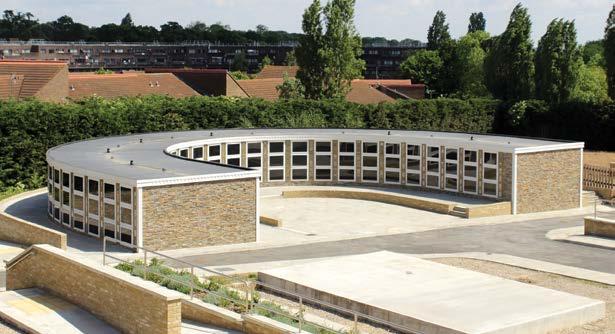

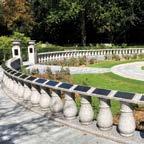

Our NEW Brochure is now available! Greenbridge Designs is dedicated to providing innovative products that add real value to cemeteries and crematoria. With focus on design as well as function, our exciting range of memorials, mausolea and vaults have been developed to fulfil the needs of cemeteries and crematoria in the 21st century. With design studios, state of the art factory facilities, a NAMM trained installation team and customer service support all based in Evesham, you can be assured of an efficient professional service throughout. For more details call 01386 848908 Or visit www.greenbridgedesigns.com
Greenbridge Bespoke Mausolea
want to maximise your online presence for free?

Highlight your Crematorium and Cemetery today!
In today's digital age, it's important to establish a strong online presence. For crematoriums and cemeteries using your Google Business Profile is essential. These profiles offer a powerful platform to connect with people and provide information. I wish to highlight Google Business Profiles and highlight key things to be aware of. Guide you on how to set up your profile, ensuring your online presence gives a good first impression.
What is a Google Business Profile?
A Google Business Profile, also known as a Google My Business listing, is a free tool provided by Google. It allows you to create an online presence on Google's search engine and maps. It provides a dedicated space where you can share important information. Engage with people and manage your online reputation.
When you search for a specific business on Google, you often see a panel on the right side of the search results page. This contains essential details about that business. This box is the Google Business Profile. It displays key information. For eg: the business's name, address, phone number, website, opening times and reviews. It also includes features like photos, posts, and a Q&A section.
The Google Business Profile acts as a digital storefront. Offering potential people a glimpse into your crematorium or cemetery. It helps you establish credibility. Improve your visibility in local searches and engage with people on Google. By managing and optimising your profile, you can enhance your online presence. And communicate your unique offerings to families in need.
How to set up a Google Business Profile?
• Create or log into a Google Account: If you don't have one already, create a Google Account or log into your existing one. Ensure that you use an email address that represents your crematorium or cemetery.
• Visit Google My Business: Go to the Google My Business website (www.google.com/business). And then follow the steps. Add Your Business Details, verify your listing and enhance/complete it etc...
Why Do Google Business Profiles Matter?
• Increased Visibility:
• Google is the go-to search engine for seeking information online. A listing ensures that your crematorium or cemetery appears in the search results. This increased visibility helps you connect with families during their time of need. Offering them the reassurance and convenience they seek.
• Detailed Information:
• Allows you to provide comprehensive details about your crematorium or cemetery. Ensuring families have all the information they need. A well-crafted profile helps you paint a complete picture for potential visitors. Emphasising your dedication to compassionate care and personalised services. This can make a world of difference to families in search of solace.
• Authentic Customer Reviews:
• People trust the experiences and opinions of others. Google Business Profiles enable families to leave reviews. And share their experiences with your crematorium or cemetery. Positive reviews act as powerful testimonials, boosting your reputation. And building trust among potential customers. Responding to positive/negative reviews shows your commitment to providing exceptional service and addressing concerns.
• Engage with Your Audience:
• Provides a valuable opportunity to engage with families. Fostering a sense of community and understanding. Responding to queries and sharing important updates shows your commitment to personalised support. This engagement can help reduce concerns and showcase the empathy you bring to your services.
Key Things to be Aware of
• Accurate Information: When setting up your listing ensure all information is accurate and up to date. Consistency in your information will help build credibility and ensure visitors can reach you.
• High-Quality Media: Include appealing and relevant images/videos of your crematorium or cemetery. These will convey a sense of serenity and tranquillity.
The ICCM Journal | Autumn 2023 | V91 No. 3 47
• Optimising for Mobile Devices: A significant amount of internet traffic comes from mobile devices. Ensure your listing is optimised for mobile, offering a seamless and user-friendly experience. This includes responsive design, easy-to-navigate and quick access to essential information.
• Consistent Branding: Maintaining consistency across all online platforms helps strengthen your brand identity. Use your logo and brand colours. A consistent tone of voice on your profile creates a recognisable and trustworthy impression. Consistency breeds familiarity, making families feel comfortable and confident in their choice.
To Conclude
Establishing a strong online presence through Google Business Profiles is an invaluable tool. Especially so for crematoriums and cemeteries. It allows you to connect with families in need and showcase your services. And it will build trust through authentic customer reviews. You can create a warm, approachable and professional online presence that resonates with families. Especially during difficult times. Embrace the power of your Google Business Profile. And watch your digital presence flourish, serving as a beacon of comfort and support.
Want more ideas and tips? Stay ahead with the latest social media and digital marketing tips, updates and more? Everything delivered straight to your inbox every week? Then why not subscribe?
You can find me, Elmer Duffy at www.fitsocialmedia.co.uk where I have a range of free resources and information. Want some assistance with getting started or building your Google Business Profile the best way? Book a free discovery call with me and let’s have a chat or if you prefer you can email me at eimer@fitsocialmedia.ie.
Thanks for reading.
tales of a cemetery registrar
Take a closer look
In this quiet piece of land, There is much living Where the dead are in the sand.
Flowers that glisten
Buddleia that bees surround, Roses that do bloom And daffs that rise from the ground.
The hidden fox holes
That are visited each night. The seagulls stomping Rising up food that’s just right.
Swifts nesting each year Around the chapel they fly, Rare breeds stop a while Before their long flight they try.
Hear chats to a child Elders with stories to tell, Don’t stop to take breath But is with love they mean well.
Friends sat on a bench
Share tales about the weather, Showing so much love They cry and laugh together.
Take a closer look
In this quiet piece of land, There is much living
Where the dead are in the sand.
By Anita Fish
48 The ICCM Journal | Autumn 2023 | V91 No. 3
Eimer Duffy
MAINTENANCE UK IFZW Maintenance Ltd. Suite C, Huffwood House Huffwood Industrial Estate Partridge Green RH13 8AU West Sussex Tel.: +44 1403 713310 www.ifzw.co.uk info@ifzw.co.uk 100 % reliability 24/7 allround service crematorium and abatement equipment - complete package from design to completed installation forward thinking flexible approach for the long term

in touch - up north
Right person for the job or right job for the person…
Hopefully it’s still a happy or enjoyable Autumn for all of us and 2023 has offered some sanity.
The joys of endless repeats and boxsets being available means that some things are easy to date. Fashions help to work out, oh that was 1990’s or 2000s. Certain technology or cultural references means that some things date quickly or things become lost.
What will confuse or remind people for years to come is panel shows or most TV series made from March 2020 until early 2022. We’ll be able to see social distancing on screen at times and where we have a panel of people or contestants, screens keeping them apart and a lack of an audience for live events.
The credits will also help with the job title – COVID advisor or consultant popping up.


Now that’s something that made me think – how the devil did they fill that role?
Your normal approach to jobs, write a job description and seek people with previous experience in the role, interview them and off you go.
So how do you employ someone for a job that didn’t exist before 2020?
The main duty of the job would have been simple I suppose –minimise the risk of anyone catching COVID.

Measurable outcomes – did people catch COVID?
No, good job – well done.
Yes, all of them – bad job, you're fired.
Joking aside, I can understand that people with experience of other health and safety and disease control would have had experience with some of the situations, however, there wouldn’t have been anyone able to say – “I have 10 years’ experience with the control of COVID-19 in work-place environments”.
Therefore, you may have had people with some experience, then using their skill set to adapt to a new disease and new approaches based on the best available tools and scientific knowledge.
TV shows continued, so that does mean that whoever was doing these jobs must have been successful and doing a good job and well done to them – even if they never win a BAFTA along with all the other hidden talent that makes the world work.
What also occurs from this, is that really, the job description and duties of these people were probably written by the applicant – they had skills from different ventures/employments but applied it to a new role.
So, while places needed a COVID advisor, the job was created around the person because of their skills. It was the right job for the person.
This goes against the normal convention of the right person for the job - you have your role, and you need the best candidate you can get, that wants the role, to fill it.
Does that mean it’s the best approach?
What if your vacant role isn’t what you really need, but it’s the role that exists at the time?
What happens if you have someone with a skillset of abilities, but you can’t fit them in or use the best of their skills for your place of work?
Do we have the flexibility to review and accurately alter a job description or a person’s role if we work out that they can offer more? Or do we have the facility to allow a person’s skills to be used to the benefit of an organisation?
Whilst we don’t need the 1997 Minister without portfolio situation or employing a person just because we want to, the changing nature of technology/society/demand placed upon organisations does invite meaningful review of roles to be necessary and thought about.
Three years ago we didn’t need COVID advisors. In three years’ time we might not need them but might need something else. The rise of AI systems and people’s fear/nervousness of their implementation is something that 10 years ago wouldn’t have been seen, however, IT and people in it, have evolved and changed their skills.
In the same manner we will have and will always have boom and bust or fads of change and future. All movies were going to be 3D after Avatar – that went well. Bitcoins are in and out of fashion and virtual reality has started, gone away, come back and whether we need a Meta graveyard we don’t know.
The job application for that one would be good – you manage a virtual cemetery for people who died in the real world, or do they manage a virtual cemetery for virtual avatar’s that died in the metaverse?
The roles may change, and they may need to change, but having the right skills and the right people with enough talent and abilities may be more important for dealing with what’s ahead and managing it well.
Trevor Robson ICCM Finance and IT Manager
The ICCM Journal | Autumn 2023 | V91 No. 3 51
from rhs chelsea flower show to the hurlet

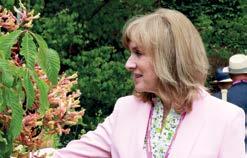
The Hurlet Crematorium has become the beneficiary of the RHS Chelsea Flower Show Gold Medalwinning Show Garden, "Myeloma UK - A Life Worth Living Garden."

The Hurlet was chosen to receive nine hero trees, hedging, and distinct landscape features from Myeloma UK's Chelsea Flower Show Garden. This exceptional garden was thoughtfully designed by Chris Beardshaw, a 10-time RHS Chelsea Gold Medal winner. The Show Garden also won the prestigious BBC People's Choice Award, marking the fifth time that Chris Beardshaw and his team have won the public vote for the best RHS show garden.
David McNaughton, Manager of the Hurlet Crematorium, said, "The magnificent specimen trees, mature hedging, stone paving, and oak path sets are currently being incorporated into our beautiful memorial gardens. Our community gardens provide reflective spaces for people to return to celebrate and remember their loved ones while benefiting from the healing power of nature.
"We are truly honoured to have been chosen as recipients of the hero trees, hedging and landscape garden features from Myeloma UK's RHS Chelsea garden.

'This accolade underscores our deep-rooted commitment to environmental stewardship and the creation of unique and
tranquil memorial spaces within our award-winning facility. We are confident that our ongoing efforts will not only enhance our site but also contribute positively to the overall ecosystem, fostering a sustainable and thriving environment for generations to come."
The Myeloma UK-A Life Worth Living Garden was inspired by the stories of individuals living with the incurable blood cancer Myeloma and was designed to raise awareness of the disease and support affected individuals.


The garden was made possible through a generous donation by Project Giving Back.
Dr Sophie Castell, CEO of Myeloma UK, said, "I am so delighted that we have been able to gift these trees to The Hurlet Crematorium so that more people can benefit from their beauty. This will be a wonderful legacy for The Myeloma UK - A Life Worth Living Garden. People with Myeloma have told us how much joy and solace they get from being in nature, and it's wonderful that we have been able to bring a piece of Chelsea to The Hurlet and the wider community."
52 The ICCM Journal | Autumn 2023 | V91 No. 3
David McNaughton, Crematorium Manager
communication is key
I always say to people that a new crematorium isn’t like other new businesses. It’s not an exciting coffee shop or a gastro restaurant that people are clamouring to try… it’s usually a place that only needs to be thought about at times of sadness. So, as a crematorium that is only four years old and situated between four established and reputable crematoria, Wealden Crematorium in Horam, East Sussex has had to work extra hard to carve out a place for itself.
One of the ways we have built strong relationships with our local funeral directors (and those further afield) is by sending out a newsletter each month (sometimes every other month). The newsletter is a mix of humorous and interesting stories about our staff, information that needs to be imparted and photos of how the grounds are looking at different times of the year.
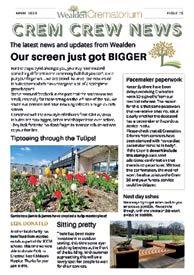


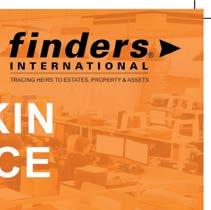

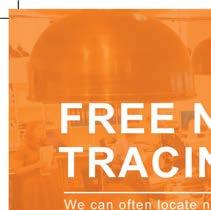
It's been well received and has helped us to build a really good rapport with our FDs (who say they love to come to us as much as possible). We were recently challenged to a 10-pin bowling competition by one of our frequent-flyer FDs. The trophy is now proudly displayed in our reception area!
With the help of these relationships and our 5-star customer service, we’ve just completed our 4000th cremation in just over four years.”
Lisa Fiddimore Deputy Manager, Wealden Crematorium

V91 No. 3
poole crematorium refurbishment
Reawakening Poole Crematorium and rebranding BCP Bereavement Care



Poole crematorium opened in 1985, under the auspices of Poole Borough Council. Poole’s first crematorium was built to ease the pressure of demand on neighbouring Bournemouth crematorium, which opened in 1938.
Poole became a popular choice of crematoria for funeral services not only amongst Poole residents but also across the northern and western side of the county covering Corfe Mullen, Wimborne, The Purbecks, Blandford, Dorchester and as far afield as Weymouth and Portland. Up until it suspended cremation operations in April 2020, Poole crematorium had carried out a total of 76,970 cremations, averaging 2,199 cremations a year, and was considered to be the busiest single-chapel crematorium on the south coast of England.
The site is located in the midst of Dorset’s largest heathland; Canford Heath. Much of it designated as a Site of Special Scientific Interest and part of the Dorset Heathlands Special Protection Area. Canford Heath is the largest lowland heath in the UK and is appreciated and protected for its unique wildlife and austere beauty being home to many rare species, as well as other heathland inhabitants. Nestled on its periphery, Poole crematorium was built within 13 acres of its own woodland glades, which were developed and maintained as an area of remembrance and thanksgiving for loved ones scattered or interred within its gardens of remembrance. In early spring, the birdsong of woodlark and distinctive churring of the nightjar can be heard at dusk, whilst mornings bring the flutter of butterflies and the buzzing of working bees amongst the English lavender, and other native grown plant species, that can be found around the grounds.
Local government reorganisation in Dorset saw the creation of two new unitary authorities replacing the nine councils previously covering the whole of the county. From 1 April 2019, the legacy councils of Bournemouth, Christchurch and Poole became BCP Council, thus beginning an extensive programme of harmonisation across all council services.
BCP Council has an ambitious programme of development and improvement underway for its crematoria and cemeteries. We have now rebranded our whole bereavement service -BCP Bereavement Care- covering services delivered within our nine cemeteries across the conurbation and two crematoria sites located at Bournemouth and Poole. Our new standalone website is in the process of being developed with ‘go live’ scheduled for summer this year. Late March also saw the implementation of PlotBox; our new bereavement software system. The new website and software system significantly enhance our service delivery, providing a gateway to all our services and improving the overall customer journey significantly for our funeral directors, stonemasons and local communities.
Currently BCP Bereavement Care carries out approximately 4,500 cremations and just under 1,000 burials each year. Out of the 315 crematoria operating in the UK, Bournemouth crematorium is the second busiest crematorium in the country in terms of cremation numbers. My bereavement team colleagues in crematory, cemeteries, ground maintenance and technical support work incredibly hard in delivering our services, and I can’t thank them enough for their staunch determination and ongoing commitment.
Poole Crematorium
In April 2020, Poole Crematorium suspended cremating. This decision was made due to the age of the cremating equipment, which required new component parts that were no longer manufactured. Without significant financial investment in cremator upgrade, it was not possible to continue to use the cremators safely at Poole and an executive decision was made to cease using the equipment.
Since this time, the location continues to function as a ceremonial venue. Nearly 2,100 services have taken place and it remains a popular choice amongst the local community.
54 The ICCM Journal | Autumn 2023 | V91 No. 3
Refurbishing Poole Crematorium

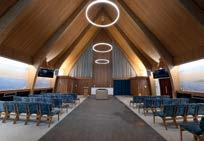
Phase 1 of our bereavement services 5-year business plan, outlined plans for significant refurbishment of the Poole site, to create a unique premier ceremonial venue, by enhancing its beautiful space within to encompass the beautiful space outside. In March last year, the site was temporarily closed. It was agreed that the memorial grounds should remain open during the build work for visitors to continue to pay their respects. It was acknowledged that visiting the grounds was an essential part of a positive grieving journey for many. Closing the grounds would have possibly led to further distress being caused to those grieving particularly in view of the lasting impact that the pandemic was having.
My vision for how the new space should look and feel was clear from the beginning. Having worked at Poole crematorium for a number of years as bereavement services manager, I had heard feedback from families, funeral directors and the team; visited other crematoria sites and spoken to industry colleagues to understand what worked well and what didn’t. This experience helped tremendously in developing a vision for what the improvement works needed to incorporate. I also forged a good working relationship with the build team. If I came up with something that they felt would not work in practical terms, we discussed and came up with alternatives that would work better without breaking the budget. They needed to understand the needs of the bereaved and the stakeholders supporting them, so our conversations were illuminating for them, in the same way discussions around building work and regulations were for me.
Skylights and Halos
Most modern crematoria offer a fresh and contemporary ceremonial room, incorporating muted shades in stone, wood, marble and granite, and often incorporate a ceiling to floor view of the grounds during the service, something I know provides value to families and mourners when attending services. Unfortunately, Poole crematorium’s original design did not include a ceiling to floor view. To have one installed retrospectively would cost a significant amount of money and time, an option that could not be considered. However, it did have a vacuous and arched wood panelled ceiling, which lent itself to the installation of a stunning set of three halo lights, graduated in height, to take centre stage and provide that ‘wow’ factor when first entering the space, hence the renaming of the hall to, The Halo Ceremony Hall.
Red Brick
Typical of a 1980s crematorium building, was the amount of red brickwork used in the original design, inside and out. Poole was abound with red brick including its off-centre catafalque topped off by a metal plate. Red brick also darkens an area with light often being absorbed into the brickwork. Some would describe the lighting as ambient in the past, the fact that mourners had difficulty in reading the order of service due to the subdued lighting was a comment made often by mourners and our funeral directors. Brickwork also affects the acoustics of the space, something else that needed to be factored in when choosing fabrics and floor coverings.
The red brick within the ceremony hall was plaster-boarded and skimmed and painted a soft shade of cream with the front of the hall covered with a weighted panel of voile on each side of the centre-piece in a light blue with a soft wave pattern woven into the fabric. The warm air circulated by the destratification fans in the ceiling create gentle movement of the voile panels, adding to the ethereality within the space.
Seating
Whilst some liked the old wooden fixed pews in place, it did mean that any alternative seating configuration for other events could not be accommodated easily. They were also quite uncomfortable. The benches have now been replaced with resplendent oak chairs, upholstered in crushed blue velvet fabric providing a ripple effect reminiscent of the sea that we are blessed to have so close by to us here in Poole. We are also able to reconfigure the seating depending on the event being hosted.
Seating capacity has now been increased to 120 within the Halo Ceremony Hall with the repurposing of a number of the ‘old style’ pews at the back of the Hall providing additional seating for the larger groups attending services.

The ICCM Journal | Autumn 2023 | V91 No. 3 55
Left Poole Chapel in 2021 and The Jacob’s Ladder tapestry that dominated for many years. Right In 1985 with bricked catafalque in place to the right .
Catafalque
I wanted a piece of furniture exquisitely crafted to showcase the coffined deceased placed at its centre. The person whose life we have come to celebrate should deservedly be centre stage. The catafalque is moveable and can be relocated or removed entirely for certain events, such as a thanksgiving or service of remembrance. Crafted in solid oak it is a beautiful piece of furniture which can be lowered at the committal stage if preferred. I believe there are only three catafalques of this design in place in the UK and it sits wonderfully framed within its newly created ceremonial space.
Murals
As mentioned, Poole crematorium sits amongst 13 acres of beautiful woodland, an extension of the adjacent heathland of Canford Heath. I wanted a mural to reflect this. My vision was to bring the ‘outdoors inside’, providing the mourner a subtle reminder of the ‘circle of life’. Lighter subdued colours in the main ceremony hall create gentle, calming and uplifting atmosphere with the main mural in the cloisters, upon exit after the service, provide a full spectrum of colours depicting the ‘seasons of life’. I wanted the murals to complement the space, not dominate, creating a uniqueness to the service taking place within providing scenery that cannot be viewed through a picture window. Joh Kennedy-Wall was the Dorset mural artist commissioned. We had many early discussions, where I emphasised the desire to depict calmness and tranquillity. I also wanted local heritage sites, such as Corfe Castle, Old Harry Rocks, Brownsea Island and The Needles depicted, with the sea being a focal point. I believe Joh captured this beautifully in her artwork, and it is so gratifying to see the effect her murals have on those who attend services.


Outdoor shelter and waiting room
Our waiting room can accommodate up to 50 people, which meant mourners attending larger services needing to remain outside. During inclement weather this can be a problem, so we created a new outdoor, standalone shelter. This provides mourners with additional covered space outside, whilst being able to view the arrival of the hearse from wooden perches for those wishing to sit down. The structure is made from solid oak with safety glass panel sections, which provide a unique focal point encompassing the main design features of the original building at which it stands adjacent to.
Two new electric vehicle charging points have also been installed, providing mourners with the option of charging their electric vehicles whilst attending services.
The integral waiting room has been completely overhauled with the red brickwork now fully plaster-boarded and painted, with the same new flooring installed in the main ceremony hall providing a more spacious and modern space.
The waiting room toilets have also been significantly updated with fresh and modern appliances creating two unisex cubicles, one family room and an accessible toilet.
Covered Floral Wreath Court
During days where rainfall was bountiful and the winds unforgiving, the open bricked wreath court was not an ideal or inviting place for mourners to gather after a service. A newly created covered wreath court, with wooden panelling and nine skylights now provides a more secluded and covered area for mourners to gather.
Flooring
The green carpet tiles that have been in place for over 20 years did their job well, but they needed to be replaced with something that was modern, hardwearing, non-slip and easy to keep clean, whilst at the same time providing a framework of subtlety and contrast with the colour scheme in place. We went for tile vinyl flooring, textured for depth and realism, and robust enough to deal with the high level of footfall within the space. We opted for a centre contrast colour piece edged in oak to guide the deceased being carried in towards the catafalque. This has worked extremely well with little intervention needed by the ceremonial team for cleaning in-between services.
56 The ICCM Journal | Autumn 2023 | V91 No. 3
Private Viewing Room
One area that always concerned me was the housing and display of the Books of Remembrance. Previously, these were displayed in the standalone conservatory adjacent to the main building, which wasn’t fit for purpose.
Part of the previous reception layout has now been utilised to create a small integral, but intimate, viewing room for these wonderful and historic books. Feedback from visitors has been hugely positive, with the local crematorium cat “Mouse”, trying to take up residency in this space on a permanent basis!
The new viewing room has been created with entrance doors with motion-sensors, assisting those with mobility issues. A new cabinet has also been crafted in solid oak to display the Books of Remembrance, which is illuminated within. Overnight, the books are removed and secured within the strong room in the main part of the building.
Office Area
The main office and its reception have also been updated providing a more welcoming environment for visitor enquiries, which provided a much-needed opportunity for a good clear out!
New Planting Scheme
To encompass the nearby heathland and woodland, some changes were made to the planting areas immediately close to the main building, the new standalone shelter and wreath court. The landscape design is of a naturalistic, pollinator-friendly planting scheme, with a cool, muted palette of colours. Plants were carefully chosen for their form and have been planted in large drifts that flow into each other. Grasses play a large part in the scheme, and provide height, movement and sound in the summer months, and structure within the winter months. We look forward to the planted areas establishing over the next few years and adding to the serenity and beauty of the site.
A small wildflower area has also been created and will greet visitors to the site when in full bloom in the summer months. Previously, this was an area of brambles and shrubland which was stripped and backfilled to create a working canvas for the wildflower blooms and our pollinator friends.
Sustainable Energy Efficiency
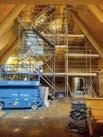
In support of BCP Council’s Climate and Ecological Emergency Declaration, the building underwent a complete overhaul in terms of its energy and water provision.
Four air source heat pumps have now been installed replacing the highly inefficient gas boilers. These improve performance, cost less, and provide far superior heating capacity. Additionally, installation of two low-wattage destratification fans in the main hall has helped enormously in efficiently redistributing the heat that rises within the space, pushing the heat back down into the main occupied space below where it is needed during services, further reducing the heating bill. Prior to the works, some people found the old ceremony space cold. However, since our improvements, I’m pleased to report that the Halo Ceremony Hall has been described as ‘warm and cosy’ during services, even during very cold spells.
‘Point of Use’ water heating has also been installed within all toilet, shower and kitchen facilities, providing immediate production of hot water, which avoids heating water which isn’t used.
All lighting has been replaced with motion sensor, energy efficient LEDs. No more ‘forgetting to turn off the lights’ but it does lead to regular arm exercises for those working in the office area when the lighting automatically turns off when sat at your desk motionless or deep in concentration. Brings new meaning to ‘sitting in the dark’!
What the future holds…
In March, BCP Council’s Cabinet gave approval to progress and develop a new business case to install two new electric cremators at Poole Crematorium, with a view to commencing cremation operations in summer 2024. This is exciting news and a decision that has been welcomed by the local community. Such technological investment would make Poole crematorium one of the ‘greenest’ crematoria in the UK, in view of its sustainable cremation, heating, electrical and water provision credentials.
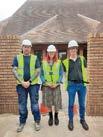
Watch this space for my next update from BCP Bereavement Care- I’ve got a busy few months ahead of me, that’s for sure!
Liz Hall
Bereavement, Coroners & Mortuary Manager
The ICCM Journal | Autumn 2023 | V91 No. 3 57
Poole Ceremony Hall –removal of Skylights
The Build Team: Mark Browning, Liz Hall and Mike Morris





























58 The ICCM Journal | Autumn 2023 | V91 No. 3
a look at london's victorian cemeteries




Part 3: The Landscapes of London’s Victorian Cemeteries
London’s cemeteries contain many fine memorials from the Victorian period, and a whole series of articles could be devoted to this subject. A visit to Kensal Green and its neighbour St Mary’s RC, Brompton, Paddington Old, the City of London or Westminster Hanwell cemeteries will be richly rewarded in a quest to find examples in a variety of designs, sizes, materials, and state of preservation. The final part of this series showcases just a handful from the capital’s many nineteenth century cemeteries.
The majority of memorials would have been supplied by local stone masons. Most had showrooms and works adjacent to or opposite cemeteries to attract prospective customers making their way to visit a grave; similarly, the location was convenient for those erecting the memorials. Henry Dunkley next to Abney Park, Henry Daniel opposite Nunhead and Welbelove & Sons adjacent to Kingston cemetery are all examples. It was, however, the memorials that were advertisements as burial authorities required masons to inscribe their trading name on the stone.
Two points are worth highlighting. First, the vast majority of memorials were designs from the monumental mason’s catalogues. Headstone and bases would have been mass produced leaving the letter cutter to complete the inscription. Similarly, component parts such as the cross, broken column or draped urn would have been assembled as required. Angels and similar figures were often carved in Italy and imported.
The second point is that the nineteenth century concluded over 120 years ago and since then many memorials from this period have deteriorated, particularly if they were carved from marble. This material does not weather well in the London environment. In addition, the impact of nature, ground movement, clearance policies and vandalism have not helped. Those constructed using granite have fared better. Other materials were utilised such as the hardwearing terracotta and also iron for decorative railings and pre-cast grave markers. Only a few were made from artificial stone, such as the Mulready monument at Kensal Green. The few wooden grave boards have been lost to the elements.
Symbolism can be found on many memorials from the period, including the hour-glass, skull, clasped hands, anchor, tree and torch. The images in this article offer only a brief insight into the wide range of memorials.
This sarcophagus for Cromwell Fleetwood Varley (d.1883) can be found in Bexleyheath Cemetery. He was an electrical engineer and pioneer in the use of submarine cables. The memorial contains a portrait sculptured in relief. A further example of such sculpture is for Dr Henry Prangley at Beckenham Cemetery.
The Revd Charles Haddon Spurgeon was a noted preacher and founder of the Metropolitan Tabernacle at the Elephant & Castle. He died in France in 1892 and is buried in West Norwood Cemetery.

The ICCM Journal | Autumn 2023 | V91 No. 3 59
A large sarcophagus commemorates the Hollingsworth family at Hillingdon Cemetery.


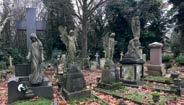

Intricately carved angels and other figures have often been vandalised. Heads and hands are absent, while others have been toppled. Few have escaped unscathed at Putney Vale Cemetery. This row of unblemished examples can be found in the depths of Islington St Pancras Cemetery.
An ensemble of memorials not far from the chapel in Queen’s Road Croydon can be said to represent all things Victorian in terms of design and materials. The angel, the urn and the decorated spire are all in good condition and even the iron chains marking out the boundary of one grave remain in situ.
Charlton Cemetery contains a memorial commemorating Jemima Ayley who died in 1860. She lies in effigy, medieval style, beneath a little domed canopy. The precise minute of her death in 1860 is recorded on the inscription and the story goes that her sister died in Norfolk on the same day. Apparently, the vault beneath the monument is 22ft deep and houses a table and chair, for use by mourning relatives. The memorial has weathered considerably and is in urgent need of restoration.
Two partly draped beehives can be found on the Norwood Vault (1872) at Chingford Mount Cemetery. A single beehive also appeared on the Norwood grave (1864) at Abney Park. It is understood that the early Christians carved beehives on their tombs as a symbol of the immortality brought by Jesus’s Resurrection. Alternatively, the folklore tradition of “telling of the bees” ensures they were informed of their keepers’ lives, such as long journeys, births, marriages and deaths. If the bees were not “put into mourning” after being informed of a death, it was believed they might fail to thrive or leave their hives.

Child mortality during the nineteenth century was at an all-time high. Despite this fact, memorials to children are comparatively rare. This example of an infant sheltering beneath a temple open on three sides can be found at Fulham Palace Road. Sadly, the memorial is weathered and has sustained vandalism.
The Victorians made good use of terracotta on their memorials and many examples can be located. This tough material was used for the Gothic-style mausoleum containing Sir Henry Doulton (and built by his own firm in 1897) and also the Romanesque-style equivalent for Laura Stearnes (1900) at Nunhead. There is an ornate terracotta kerb memorial on the Sullivan grave at Putney Vale, an obelisk commemorating James Brown (1884) at West Norwood and a number of smaller terracotta memorials in the Jewish Cemetery in Glebe Road, Willesden.

60 The ICCM Journal | Autumn 2023 | V91 No. 3
Animals feature on a small number of memorials; two can be found at Highgate: the sleeping mastiff (call lion) on Tom Sayers tomb (1865) and the recumbent lion commemorating the menagerist George Wombwell (1850). A large lion can also be seen on the Jackson memorial (1872) at Brompton.
Subterranean vaults and brick graves are a feature of many cemeteries. Most have to be dismantled to permit further burials. One exception is the substantial Parsons vault at Greenwich which is entered through a stairwell lined with ceramic bricks.

The monument in West Norwood Cemetery to the linen draper Alexander Berens (1858) has been described as ‘one of the finest High Victorian monuments in the country’. It resembles a mediaeval sarcophagus and was designed by EM Barry. The materials used are pink granite, marble and Portland stone. There are also Minton tiles with a B for Berens along with the image of a black bear. This Gothic-style memorial cost £1,500 to build and was restored in 2014.
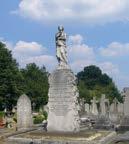
Iron railings and chains for decoration and protection can still be found around many graves despite the tendency for such items to be removed during World War Two. Classic examples can be Westminster Hanwell, Hither Green, Putney Lower Common, New Southgate, Tottenham (seen here), West Ham and Woolwich.
Frederick Leyland’s ‘Arts and Craft’s’ tomb at Brompton dates from 1892. The memorial to the shipowner and patron of the Pre-Raphaelites was designed by Edward Burne-Jones. The Royal Parks website offers the following description:
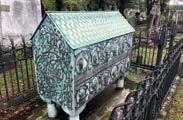
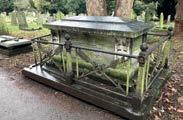


‘The chest tomb is made from Portland stone, with a cooper roof, and is covered with floral copper work. The wrought iron railings that surround it are topped with ornate lilies. It’s the only tomb created by Burne-Jones, who is best known as a painter and stained-glass designer. It’s listed grade 2* by Historic England for its significance.’
At Kensal Green can be found the memorials to Major Gen Sir Archibald Galloway (1850). The architectural historian James Steven Curl describes it as a ‘Medievalising trophy of arms and armour’.
Adjacent to the chapels in Kingston Cemetery is the large Ranyard memorial commemorating Elizabeth and William. Also buried here is Arthur Cowper Ranyard (1845-94), Secretary of the Royal Astronomical Society and editor of Knowledge.

The ICCM Journal | Autumn 2023 | V91 No. 3 61
The memorial for John Allan was placed in Nunhead Cemetery following his burial in 1865. The tomb is based on the Payava tomb at Xanthos and is claimed to be the most expensive monument in the cemetery. Not surprisingly, it has been listed by Historic England.
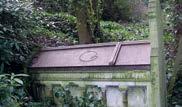
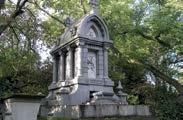
Known for his report into burial practices and funeral cost (1843), Sir Edwin Chadwick died in 1890 and is buried in Mortlake Old Burial Ground. Unusually, the inscription to Sir Edwin and his wife can be found on opposite sides of the flat memorial.

Despite clearance there are many good examples of nineteenth century memorials remaining in Paddington Old Cemetery in Willesden Lane, Kilburn. Jabez Burns was a preacher, author, philanthropist and temperance reformer who died in 1876. His memorial is surmounted by a fine bust.
Also in Paddington Old Cemetery can be found the pink granite memorial commemorating Edward Mannouch (1883) which possesses prominent bronze lettering that had withstood the last 150 years.
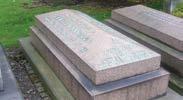
The incised pallet on the Harvey memorial (1866) in Richmond Cemetery symbolises his occupation as a painter and also demonstrates the hard-wearing property of granite.
Kaikhoshru Puntheki (1890) was a Parsee lawyer from Bombay and his memorial is a flaming urn. It is to be seen in St Mary’s Cemetery in Battersea.

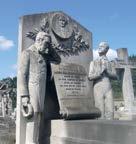
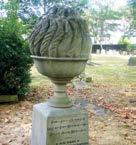
St Mary’s Roman Catholic Cemetery at Kensal Green is often overlooked by cemetery aficionados, yet a visit is richly rewarded. In addition to the twenty plus mausolea and an extensive and wellmaintained catacomb under the chapel, there are many interesting memorials. Near the cemetery chapel is the husband and son mourning Luisa Fowke (1890).
A further memorial of note is the large chest supported by animals.

As mentioned in the introduction, many memorials came direct from the mason’s catalogue. Larger memorials were in parts which could be assembled according to the client’s requirements. This granite obelisk can be found at Wandsworth cemetery; a not-dissimilar structure, but used as a drinking fountain, can be found in Chatham Cemetery, Kent.
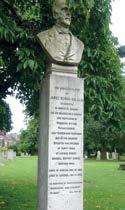
62 The ICCM Journal | Autumn 2023 | V91 No. 3
The Bent family memorial in Brookwood Cemetery was one of the first to be erected after the cemetery opened in 1854. Constructed using Bathstone, a belfry-like central section was surmounted by a short spire. It was a flamboyant Gothic-style structure, but as the photo indicates, it is now in an advanced state of deterioration.
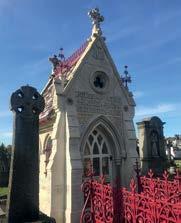
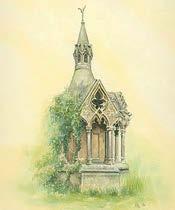
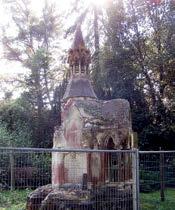
Around 80 mausolea were constructed in London cemeteries during the nineteenth century. Many can be found at Kensal Green, St Mary’s Kensal Green, Brompton, Brookwood and Islington St Pancras. Some have just one example, such as Hither Green and South Ealing. Most are in the Gothic-style, but Egyptian and classical can be seen. Coffins are either accommodated on shelves at surface height or in a subterranean chamber. The mausoleum in the City of London Cemetery for William J Haywood, who designed the cemetery, contains the ashes for him and his wife.
The mausoleum for the Marquis de Misa at St Mary’s RC Kensal Green is a little Gothic chapel with colour tiles. It was recently restored and is one of 24 in the cemetery.
The Egyptian style is well represented.
The triangular vault containing Sir Loftus Otway, a calvary officer from the Peninsular war can be found in the west side of Highgate Cemetery.

All images from the author’s collection, with the exception of the Bent memorial which is used by courtesy of John M Clarke.
www.brianparsons.org.uk
The sixth edition of London Cemeteries: An Illustrated Guide and Gazetteer by Hugh Meller and Brian Parsons has just been published by The History Press.
The History Press | London Cemeteries

The ICCM Journal | Autumn 2023 | V91 No. 3 63
Brian Parsons
ashes to blooms
Ashes to Blooms came about in early 2022, after the loss of my 12-year-old Netherland Dwarf rabbit, Lucy Rabbit. After losing Lucy Rabbit, I couldn’t find any service or product that I felt would be an appropriate tribute to my beautiful and naughty girl, and so I went about setting-up Ashes to Blooms. I take the ashes of a loved one, whether a beloved person or a special pet, and combine them with a unique combination of UK native wildflower seeds and other natural ingredients to create bespoke memorial seed balls, as unique as my clients’ loved ones. Clients can give these to friends and family to scatter in a special place, and they can then watch their wildflower memorial grow.
After the unexpected loss of my brother, last August, it was an honour to create seed balls, alongside my parents, using my brother’s ashes. This summer we will all plant our seed balls in our gardens and on our balconies, and he will grow with us.
At the moment there is an incredible focus on the environment, and this is at the heart of everything I do. All ingredients in the seed balls are natural and the wildflower seeds I use are all from varieties native to the UK. These flowers are ideal for attracting bees and butterflies to our gardens and helping to restore their habitat, much of which has been lost as a result of development and chemical use. I use no artificial ingredients in my seed balls and I use recycled packaging and marketing materials, wherever possible.


All products are made by hand, by my family business, in the town of Worthing, in West Sussex. In 2023 I was shortlisted for the Adur and Worthing Business Awards’ Sustainable Business of the Year Award. There is nothing similar in the world and I am delighted to be able to offer clients an ecological alternative for remembering their loved one.
Background
I was born in Worthing and have lived here all my life, apart from my time at University and a brief spell in Brighton. Growing up, we had a full house, with mum, dad, my two younger sisters, my older brother, foster children and myself. In addition, at one time or another, we had also every imaginable pet, including Vietnamese pot-bellied pigs, stick insects, dogs, cats, horses, chickens, ducks, bantams, fish, rats, mice, gerbils, guineapigs, rabbits & more! As a result, I was raised as an animal-lover and a house without animals has never felt like home.
After a relationship breakdown in 2009 I decided that it was the right time to find a companion animal. In the summer of 2010 I was at the South of England Show at Ardingly, when I came across a beautiful Netherland Dwarf rabbit, later to become known as Lucy; I instantly knew that she was the girl for me! She came home with me that afternoon, and she was the best companion for almost 12 years. Lucy lived free in my lounge, and made it entirely hers! We referred to it as "Lucy's lounge", as she was very much the boss of the domain. Lucy was full of love, enjoying strokes & cuddles, as well as being feisty & endlessly naughty!

By January 2022 Lucy had really slowed down as a result of arthritis, and on 27th January 2022 I made the heart-rending decision to have her put down. I was distraught and there seemed like no way to do justice to the companion she had been and the incredible happiness and fun she had brought to my life, over the past almost 12 years. It was as a result of this loss, that I set about creating Ashes to Blooms.
Since coming-up with the idea for Ashes to Blooms in March 2022, I have managed to build a website (battling endless 'error' messages), worked out a method of production, sent endless emails and samples to people who I hope can see the benefits of our service, started to learn marketing and have just secured trademark protection. I am so grateful to my friends, partner and family for their endless advice, technical assistance, leaflet-drops and social media 'likes', 'shares' and 'follows'.
I now take pleasure in carefully fulfilling every order, creating seed balls which go on to create a beautiful wildflower memorial for each of our clients. This was not an option when I lost Lucy, but I am delighted to be able to offer this this to my clients. Please get in touch with David, to discuss further, either by email at info@ashestoblooms.com, or on 07732 095 257.
David Holmes

64 The ICCM Journal | Autumn 2023 | V91 No. 3
improving service reputation by helping the bereaved deal with the burden of admin following a death
The challenge for families
Losing a loved one is an emotional and difficult experience, and dealing with the practicalities after their death can add an overwhelming burden to the grieving process. When someone passes away, their families often need to contact multiple companies ranging from banks and building societies to utilities and insurers to either close or transfer accounts. This can be a time-consuming and distressing process, particularly when combined with the challenges of planning a funeral, settling an estate, and dealing with grief.
In addition to the practical difficulties, the process can be emotionally upsetting. Each account or subscription can serve as a reminder of the person who has passed away, and closing or transferring them can feel like a final separation from their loved one.
Tell Us Once
The "Tell Us Once" service is a UK government initiative designed to simplify the process of informing different government departments and agencies when someone passes away. The service is available to anyone who registers a death in England, Wales, or Scotland.
When the family registers the death they are given a code that can be used online or by phone to notify all the major government departments. This includes notifying the Department for Work and Pensions, HM Revenue and Customs, the DVLA, and the Passport Office, among others.
By using the Tell Us Once service, the person registering the death is able to avoid having to contact each of these departments and agencies separately, which can be timeconsuming and confusing during a difficult and emotional time. The service is also designed to reduce the risk of identity theft by ensuring that sensitive personal information is only shared with government departments and agencies that need to know.
It's worth noting that the Tell Us Once service is not available in Northern Ireland, where a similar service called "Notification of Death" is provided by the Northern Ireland Direct service. The Notification of Death service works in a similar way to Tell Us Once, but is only available to people registering a death in Northern Ireland.
Tell Us Once is now offered by every local authority in Great Britain, but doesn’t deal with the issue of notifying private companies such as banks, pension providers, utilities, credit cards and other household bills.
Life Ledger

Life Ledger launched in January 2021, at the height of the pandemic, following the personal experience of the founders. The process for notifying private companies was (and still is) very time-consuming, fragmented and
upsetting. The response times from companies also vary wildly from a few days to weeks.
The service is free to use, and allows families to tell over 1,000 companies from one place, in minutes, avoiding the need for lengthy and repetitive phone calls. It includes a simple dashboard where users can view the progress of and manage all their notifications, upload documents and directly message the companies. Security is of paramount importance, so the database uses advanced encryption and security measures to ensure that everything is stored securely and can only be accessed by authorised individuals.
The service has grown rapidly in popularity and is on target to help 30,000 families in the UK in 2023. It is signposted to by funeral directors, hospices, parts of the NHS, some local authorities, and many of the leading grief charities in the UK.
How can you help?
Signposting both Tell Us Once and the free Life Ledger account closure service can be a valuable tool to improve customer satisfaction for many organisations. By recommending these services you will be providing a much-needed level of bereavement aftercare. This can be as simple as providing information on your website in the form of a link under “Useful Resources” or a dedicated page that explains the help available.
Providing awareness of the resources available helps customers navigate a difficult and emotional time, showing that organisations can provide value beyond their core products and services.
As a result, customers are more likely to feel loyal and valued, which can lead to increased retention and reputation in the local community.
For more information please visit www.lifeledger.com or message Dan Blackett, Partnerships Manager at dan@ lifeledger.com to discuss how your organisation can get involved and help us reach more people at their time of need.
Dan Blackett
The ICCM Journal | Autumn 2023 | V91 No. 3 65
running for bliss
Have you ever watched something on TV and thought I could do that? Well after years of watching thousands of people run the London Marathon each year I decided to enter too. If people carrying fridges, or dressed as rhinos and knights can do it, then why not me?
I have always enjoyed taking part in sport. As a child I swam for my local swimming club in Cockermouth and later played water polo as a junior and senior. I started running after finishing a sprint triathlon and realising that the run was my weakest discipline. I have since completed ten half marathons and numerous 10 mile, 10k and 5k races (including parkruns and ‘Hell up North’) and I train with a group in Cockermouth which is coached by a world champion rower in the masters age group. I still swim regularly, though for fitness rather than competitively.
I entered the ballot for the 2024 race (along with half a million other people) but then decided I wanted to run for a charity, and it had to be a charity close to my heart that would spur me on to train and complete the race.
I chose to run for Bliss and I wanted to tell you all why.
The rate of babies born premature or sick in the UK is rising with 1 in every 7 babies needing neonatal care. Bliss is continuing the fight to improve outcomes and quality of life for these babies - but we need your help to do that.
Bliss exists to give every baby born premature or sick in the UK the best chance of survival and quality of life. We champion their right to receive the best care by supporting families, campaigning for change and supporting professionals, and enabling life-changing research.
Bliss was founded in 1979 by a group of concerned parents who discovered that no hospital had all the equipment nor the trained staff it needed to safely care for premature and sick babies.

Determined to do something, these volunteers formed a charity to give vulnerable babies the care they deserve. 40 years later Bliss has grown into the leading UK charity for the 90,000 babies born needing neonatal care every year.
• Over 60 per cent of babies in neonatal care are born full term but sick. The five most common conditions are respiratory problems, infection, hypoglycaemia, jaundice, and asphyxia/HIE.
• 60,000 babies are born prematurely in the UK each year and most premature births are spontaneous, with no clear cause. Many of these babies will need urgent neonatal care after birth.
• Premature birth can result in lifelong conditions such as cerebral palsy, behavioural and long-term health problems. Some research has also found that the earlier a baby is born the higher their risk of having special educational needs at school.
• The UK has one of the highest rates of premature birth in the world, ranking 134 out of 184 countries. This is higher than many countries in Europe and higher than Peru, Chile and Egypt.
• The emotional and financial burden of having a baby in neonatal care can be huge. Parents are more likely to suffer from post-natal depression and on average they spend an extra £282 per week while their baby is in hospital.
• Premature birth is the leading cause of death among children under one in the UK, and children under five worldwide.
• The average length of time a baby spends in neonatal care is eight days, but babies born at less than 27 weeks of pregnancy spend an average of 93 days in hospital.
• The average cost to the NHS of a day of neonatal care is £805, meaning that if every baby spent just one day less in neonatal care a staggering £60 million would be saved each year.
• Two-thirds of units in England do not have enough medical staff to meet safety standards and 70 per cent of intensive care units look after more babies than is safe.
I am running the 2024 London Marathon in memory of our baby son Daniel, who left us too soon on the 1st of April 2009. Our twins, Daniel and Michael were born extremely premature at just 24 weeks and one day in James Cook University Hospital, Middlesbrough. They weighed just 1lb 7oz each and were no larger than my hand. They were both taken into the Neonatal Unit at James Cook where they received the best possible care from the amazing nurses and doctors.

Sadly, Daniel was too poorly and passed away at just six days old.
We stayed at the hospital for the next three months while Michael grew stronger and bigger, and our lives revolved around
The ICCM Journal | Autumn 2023 | V91 No. 3 67
doing his 'cares', watching him grow bigger and seeing all the various medications he was on gradually reduce. He endured different types of ventilation, a couple of blood transfusions, and two operations while still a tiny baby. We loved the 'kangaroo care' days where we got to hold him.
Michael finally left Middlesbrough after 99 days and spent two weeks in Whitehaven Hospital before coming home close to his original due date. He is now 14 and a grumpy teenager (sometimes!), not bad for a tiny baby who had the worst possible start to life, with a 10% chance of survival.
We had amazing support from family, friends, and the NHS staff throughout our time at James Cook Hospital and we don't know what we would've done without it. Looking after a sick child consumes your whole life and you never quite know if there is light at the end of the tunnel.
I have been inspired by many friends who have run the London Marathon, and I want to raise money for Bliss to help them support as many families as they can.
Please help me to support this wonderful charity.
https://www.justgiving.com/fundraising/peter-haley3
I am also raising funds for Bliss by collecting used ink cartridges and sending them to Recycle4charity who will donate up to £2 per cartridge. If you use the link below you can send cartridges on my behalf and the funds raised will go directly into my fundraising for Bliss.
http://www.recycle4charity.co.uk/Register/859589
Thank you so much for any support you can give me.
Peter Haley
I work as a Specialist (Bereavement Services Officer) for Bereavement Services in the new Cumberland Council in West Cumbria.
Member interaction is the Institute's lifeblood.
iccm branch secretaries, contact details
Northern: Graham Harrison
Email: Graham.Harrison@durham.gov.uk
T: 03000 265 606
Eastern: Tracy Lawrence
Email: TLawrence@nenevalleycrematorium.co.uk
T: 01933 229 660 or 07904 457 372
South East: Heather White
Email: heather.white@southampton.gov.uk
T: 023 8076 6405
Midlands and Mid Wales: Michael Birkinshaw
Email: bereavement@bromsgroveandredditch.gov.uk
T: 01527 62174
North West and North Wales: Dave Jennings
Email: Dave.jennings@trafford.gov.uk
T: 0161 912 1515
68 The ICCM Journal | Autumn 2023 | V91 No. 3
Why not facilitate a branch meeting?
cancer research charity hike
After many months of taking part in lots of various outdoor activities, myself and two members of the bereavement services team decided we wanted to challenge ourselves and take part in a walking challenge as we all love being outdoors and know how good this is for our mental health, fitness and to meet new people. As we knew the challenge would be tough, we wanted to raise as much money as possible, so we choose a charity close to everyone’s hearts-Cancer research UK. Sadly, in the meantime a close friend was diagnosed with cancer, so it made the challenge even more poignant and us all more determined to complete the challenge and raise as much money as possible.
So, on Saturday 3rd June (bereavement services staff aka The Crem Crusaders) also my partner and Andrea’s partner took part in the one-day long distance hiking challenge in the Peak District for Cancer Research. We all managed the marathon 26 mile hike in hot baking sun and proudly raised £1,745.60 for life-saving research. We are all really proud of ourselves for completing the challenge. We hope that we may even inspire people in the future to take park in such events.

51 mile charity walk - team fundraising for multiple charities
The Association of Greater Manchester’s Bereavement Services Group will be taking part in a 51 mile walk over 2 days where we will visit a cemetery or crematorium site within each of the 10 Greater Manchester authorities. This will take place on Thursday 7th and Friday 8th December 2023.
This has been organised to coincide with National Grief Awareness Week and is aimed at raising the profile of two charities that work closely with the group. ‘Andysmanclub’ and ‘Once Upon a Smile’. All money donated will be split equally between the charities to support the great work that they do in partnership with all the Greater Manchester local authorities bereavement teams.
"The Walking Team" Barry Ellis (Salford) Dave Jennings (Trafford) Becky Seed (Trafford) Andy Bond (Wigan) Mark Birchall (Wigan) Mike Gurney (Tameside) Dominic Lunn (Manchester) Graeme Douglas (Rochdale) Amanda Brown (Bury) Julie Dunk (ICCM).
Support Team Jayne Murphy (Oldham) Diane Murphy (Manchester) Luke Smith (Salford)
Please donate if you can https://www.justgiving.com/team/gmwalk
The ICCM Journal | Autumn 2023 | V91 No. 3 69
Liz Buckley














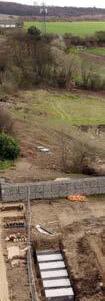
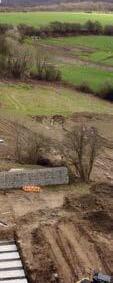


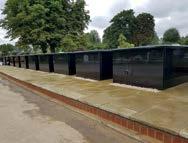
















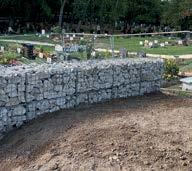



70 The ICCM Journal | Autumn 2023 | V91 No. 3 Knowledge, Expertise & Understanding Full Installation & Product Design Service gemprecast@live.com www.gemprecast.co.uk Granite Chamber s Chambers Spec oject s Installation Gabion Walls Drainage Design, Manufacture, Supply & Installation under one roof NEW Full in house cemetery development service
iccm board of directors
President
Heather White, MICCM (Dip), Southampton City Council
Tel: 023 8076 6405 Email: heather.white@southampton.gov.uk
Deputy President Marian Millington, AICCM Email: marianw69@gmail.com
Chair Martin Birch, FICCM (Dip), The City of Cardiff Council Tel: 029 2054 4820 Email: Mbirch@cardiff.gov.uk
Vice Chair
Kevin Pilkington, FICCM (Dip), London Borough of Croydon Email: kevin.pilkington@croydon.gov.uk
Alan José, FICCM, Westerleigh Group
Tel: 07881 106 948 Email: ajose@westerleighgroup.co.uk
Tim Morris, FICCM (Dip) Email: iccmtim@gmail.com
Mohamed Omer, Gardens of Peace Muslim Cemetery
Tel: 020 8502 6000 Email: mohamed.omer@gardens-of-peace.org.uk
Linda Barker, FICCM (Dip) Email: barkerlinda1@aol.com
iccm officers
Chief Executive
Technical & Member Services Officer
Technical Services and Journal Officer
Julie Dunk, BA (Hons), FICCM (Dip)
Mob: 07976 939 585 Email: julie.dunk@iccm-uk.com
Mathew Crawley, PGDip FCMI FICCM(DipHons)
Mob: 07581 006 035 Email: mathew.crawley@iccm-uk.com
Sofia Allana, FICCM (Dip) Tel: 07502 627521 Email: sofia.allana@iccm-uk.com
COTS Manager Martin Clark, FICCM
Mob: 07940 032 035 Email: martin.clark@iccm-uk.com
Finance & IT Manager
Trevor Robson, Bsc (Hons) BSIT, AICCM, MAAT
1 Colbeck Avenue, Swalwell, Newcastle upon Tyne, NE16 3EB
Tel: 0191 452 5958 Email: trevor.robson@iccm-uk.com
Administration Officer
Julie Darroux, AICCM, ICCM National Office
City of London Cemetery, Aldersbrook Road, Manor Park, London, E12 5DQ
Tel: 020 8989 4661 Email: julie.darroux@iccm-uk.com
The ICCM Journal | Autumn 2023 | V91 No. 3 71
advertiser index
the journal
The Journal is the official quarterly publication of the Institute of Cemetery & Crematorium Management (ICCM). It is the aim of the Journal to encourage the fullest freedom of opinion and expression within the Institute. Unless the fact is expressly stated, therefore, views put forward in the Journal should not necessarily be regarded as expressing the considered policy of the Institute.
The Editor and the ICCM do not guarantee the accuracy of statements made by contributors or advertisers or accept responsibility for any statement which they may express in this publication or inserts therein. No advertisements referring to the provision of training or training centres or any other services will be accepted where it is considered that a conflict with the functions of the Institute exists. Articles are considered for publication on the basis that they are the author’s original work.
No part of this publication may be reproduced, stored in a retrieval system, or transmitted in any form or by any means, electronic, mechanical, photocopying or otherwise without the prior written permission of the ICCM.
Institute of Cemetery & Crematorium Management (Inc.)
Registered Office: City of London Cemetery
Aldersbrook Road
London E12 5DQ
A Company Limited by Guarantee
Founded 1913
Incorporated 1958
England & Wales Register Number 610299
72 The ICCM Journal | Autumn 2023 | V91 No. 3
BACAS IBC CDS 40 Deceased Online 50 Edge IT Systems Limited 42 Facultatieve Technologies 17 Finders International 53 Fordingbridge 7 Fraser & Fraser 15 GICM 20 Greenacre Innovations-Gem Precast Ltd 70 Gower Consultants Ltd 28 Granart 66 Greenbridge Designs 35 & 46 IFZW Maintenance Ltd 49 Obitus 22 OpusXenta 11 Pear Technology 45 PlotBox 6 Fibrous Funeral Supplies 58 Teleshore UK Ltd IFC, 36 & 37 TGMS Ltd 18 The Columbaria Company 27 Welters Organisation Worldwide 3
72







































































































































































































































































































